
Please send all Checks and Money orders to :
Dave Taylor P.O. Box 87 Sylvania, OH 43560
419-842-1863
Click Here to E-mail Us!
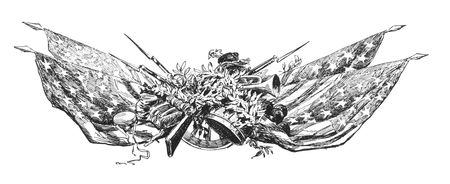

15 11 second list
LAYAWAYS ARE WELCOME:
Need to split your order into multiple payments? No problem! A simple 20% earnest money deposit will hold your item for you.
You can then pay it off in easy installments that fit your budget.
Read Terms Here
~~~~~~~~~~
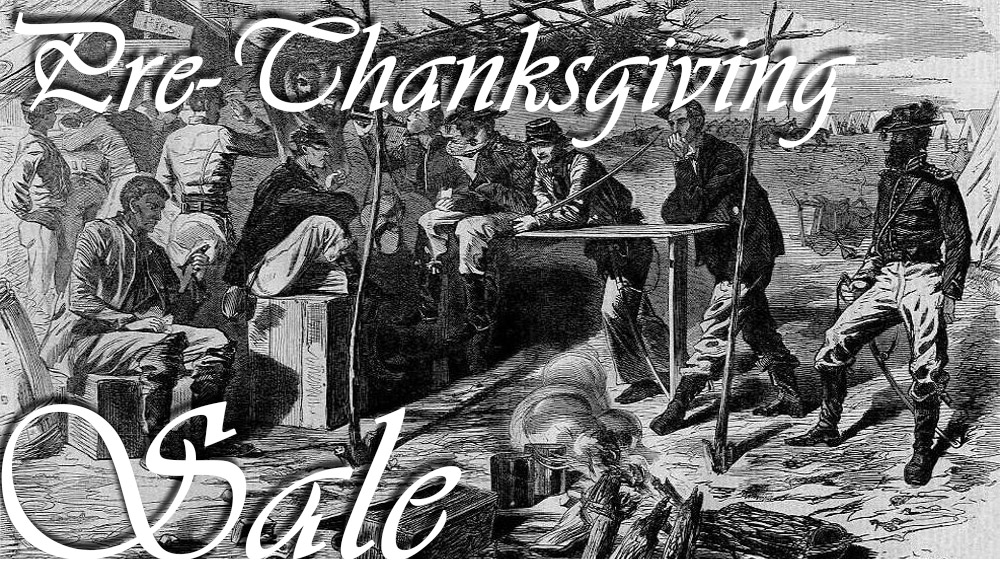

15-11-50 … Two Charleston Harbor Cannoneers Effects / Only One Came Home! …
Rhode Island Historical Documents and Related Items Including General Burnside s Autograph, maybe that of President Hayes, General Terry, and a Wartime Artillery Fire Table Written in the Field. A really interesting lot of ephemera related to Rhode Island brothers James Allan Seaver (1841-1896) and William Henry Seaver (1837 or 1839-1865.) One made it through the war. The other died literally almost in sight of home. Many of the documents have separations at the folds that can be EASILY repaired using archival document tape. I am leaving that conservation for the next owner so I can sell this now.
The most significant piece in this grouping is James Seaver s NCO warrant as third corporal in Capt. Van Slyck s company of the 1st Rhode Island, signed by Ambrose Burnside. Seaver had been a member of Van Slyck s prewar militia company, the Providence Artillery and went with it into the 1st RI Detached Militia under Burnside in the days following Fort Sumter. The warrant is filled out in bold lettering, with nice seal of RI in the upper left corner. Signed clearly by Ambrose E Burnside on April 18th 1861, less than a week after the rebs attacked Fort Sumter. VG+ condition.
Seaver s 1860 warrant as second gunner in the Providence Artillery is also present, datelined HQ Providence Artillery an signed by Van Slyck. About 6 by 8 inches with a RI seal. Seaver was discharged for disability on May 31, but enlisted again, this time with his older brother William, in the newly formed 3rd Rhode Island. The two brothers enlisted and mustered into Co. E on 8/21/61, James as a sergeant and William as a private. James made 1st sergeant on 1/15/64 and 2nd Lieutenant on 2/3/64. William was hospitalized in March and discharged for disability in late May, but served again later. The 3rd Rhode was an infantry regiment. They were sent south soon after organizing and took part in the Port Royal expedition and the reduction of Fort Pulaski, and then in operations against Charleston and the Confederate forts guarding it. Soon redesignated heavy artillery, the unit served largely by battery and in separate detachments performing varied duty as infantry, light artillery and heavy artillery. They saw frequent action. In addition to the above mentioned documents, this archive also includes
*An Official Rhode Island document appointing James Seaver Lieutenant Feb. 1864. One separation at a fold.
*Discharge Paper James Seaver being discharged as sergeant in April 1864 to accept commission as Lieutenant in the same unit 3rd RIHA. Poor condition separated at a fold into two sections.
*NEAT ITEM Letter 2nd Bn. 3rd Rhode Island Arty. Morris Island March 2nd 1864. Request by James Seaver to go to Hilton Head for four days. Carries numerous signed endorsements of approval on the back including an actual manuscript autograph of Alfred H. Terry. Good condition.
*Manuscript Special Orders March 4th 1864. Separated at the folds into three sections.
* NEAT ITEM Printed and Filled-out Pass to Fort Pulaski Chief QM Office Dept of the South. Hilton Head SC March 25th 1864. Pass the bears J A Seaver to Fort Pulaski. Good cond.
Perhaps because of his long experience with artillery, in March, 1864, Seaver was temporarily detached from the regiment and assigned to Battery D of the 1st US Artillery, a light battery serving in the 10th Army Corps in the District of Beaufort, S.C. How long he served with them is unclear, but there is a letter from him datelined Camp Battery D 1st US Artillery, Virginia May 28, 1864 requesting he be returned to the 3rd RIHA. (Letter separated at a fold.) He certainly returned before the regiment mustered out: there is a manuscript special orders no. 3. HQ 3rd RI Artillery Hilton Head SC Sept 12 1864, regarding Seavers company about to be mustered out and Seavers transfer to Co. C until his own muster out 10/15/64. This is followed by a Provost Marshal s Pass. NEAT ITEM. Printed, filled in, and very striking. Dated Bermuda Hundred Oct. 12th 1864 passing Lieut. Seaver to Fort Monroe Virginia. Stamped John Cassels Oct 12th 1864 Capt. & ADC Provost Marshal and cancelled by perforations. Good cond. Most likely Seaver s pass to go home.
Three further pieces relate to William H. Seaver, who was not as lucky as his brother:
*Discharge Paper William Seaver 2nd Bn. VRC dated June 16 1865. Good cond.
*Letter from a US Army Surgeon to James A. Seaver acknowledging William Seaver s death at a Rhode Island General Hospital, regretting he did not get to see his home again, although so close. Bears US Med Dept Logo in upper left corner. Printed in upper right Lovell General Hospital USA Portsmouth Grove, Rhode Island . June 19th 1865. The letter states that Wm Seaver died, his days had been numbered and asks, if a post mortem was conducted, to send him the results to see if his diagnosis was correct. Very weak at the folds with some paper loss, but a telling document.
*William Seaver s wallet. Leather large size wallet nicely ink inscribed to William Seaver Jr. (This must be William H., named after his father, who had died in 1859.) Excellent Condition. William Seaver likely had additional war service. Researching the database I find a William H. Seaver serving in two other Rhode Island units after our William H. Seaver was discharged from the 3rd RIHA: a private in the 7th RI from 7/14/62 to 3/2/63; and a private in Battery F, 1st RI Light Artillery from 6/22/63 to an undetermined date. The 7th RI private was also discharged for disability, and the date the Battery F private enlisted might be a mistake for 5/22/63, the date given for William s enlistment on his VRC discharge, so there is a chance these are all the same William H Seaver James Seaver s older brother. This would explain how he ended up in the VRC in 1865. There may be a good story here. Perhaps an attempt to live up to his younger brother s record. In the grouping are a number of other pieces.
*1877 Rutherford B Hayes signed pre printed letter on Executive Mansion stationery. Separated into three sections one separation directly through Hayes autograph. DAMN!
*Pay voucher separated into numerous sections.
*Albumen photo James A Seaver in the uniform of the 1st Regiment Light Infantry Regiment. A post war photo. VG cond.
*An 1877 printed Dept of the Interior letter separated at the folds.
Perhaps the most fascinating piece is a large 8 x 13 manuscript firing table kept by James Seaver. One of the coolest soldier documents I have owned. Titled, Table of distances from Cummings Point to the Batteries in Front with a list of the forts and the number of yards to each. Charleston Battery was a whopping 6,710 Yards Castle Pinckney 7800 yards… Ft. Sumter a close neighbor at 1,480 yards Another box of data tells how much fuze to use with a 30 Pound Parrott Gun. Other columns are Fuze, Elevation, Powder. Separated cleanly at the folds into four pieces. Displays like a million bucks. I love this artillery personal item. An interesting family archive with room for plenty more research. The Burnside signed commission and the manuscript firing table are worth the price of admission
… $1,150.00
Click Here to E-mail Us!
Call us @ 419-842-1863

15-11-51 … Tintype of Attractive Black Woman / Oral History From Georgia …
Very strong 6th plate tintype portrait of an attractive young black woman ca. 1855-1860. This young woman is posed seated, about 2/3 length, wearing a delicately tinted bonnet with long ties that are knotted beneath her chin and extend in broad ribbons almost to her waist. She wears an elaborate flounced shawl and has a brooch and finger ring or rings that have been touched with gold paint by the photographer. The clarity is exceptional and she wears a very slight, attractive, and demure smile. Obviously wearing her best for a portrait photograph, her dress and poise show her to be well-off, or the servant of a well off family. The clarity and mild tinting make it a very attractive image. Some slight abrasion marks from the edge of the oval matt, otherwise excellent. Housed in a mat, frame, and glass and the remnants of the back half of a thermoplastic case. The dealer who sold this to me related that the image had come out of Georgia. I believe him completely. The woman pictured is so well dressed that she might be one of the 3,000 or so free blacks that lived in the state in 1860, but it is just as likely that she is the personal maid of a white woman from a very wealthy family. Social status was expressed not just by your personal wardrobe, but also by the clothing worn by your house servants. This is one heck of a rare subject in any event, and very exciting to the eye …
zvcbey
… $695.00 – SOLD
Click Here to E-mail Us!
Call us @ 419-842-1863
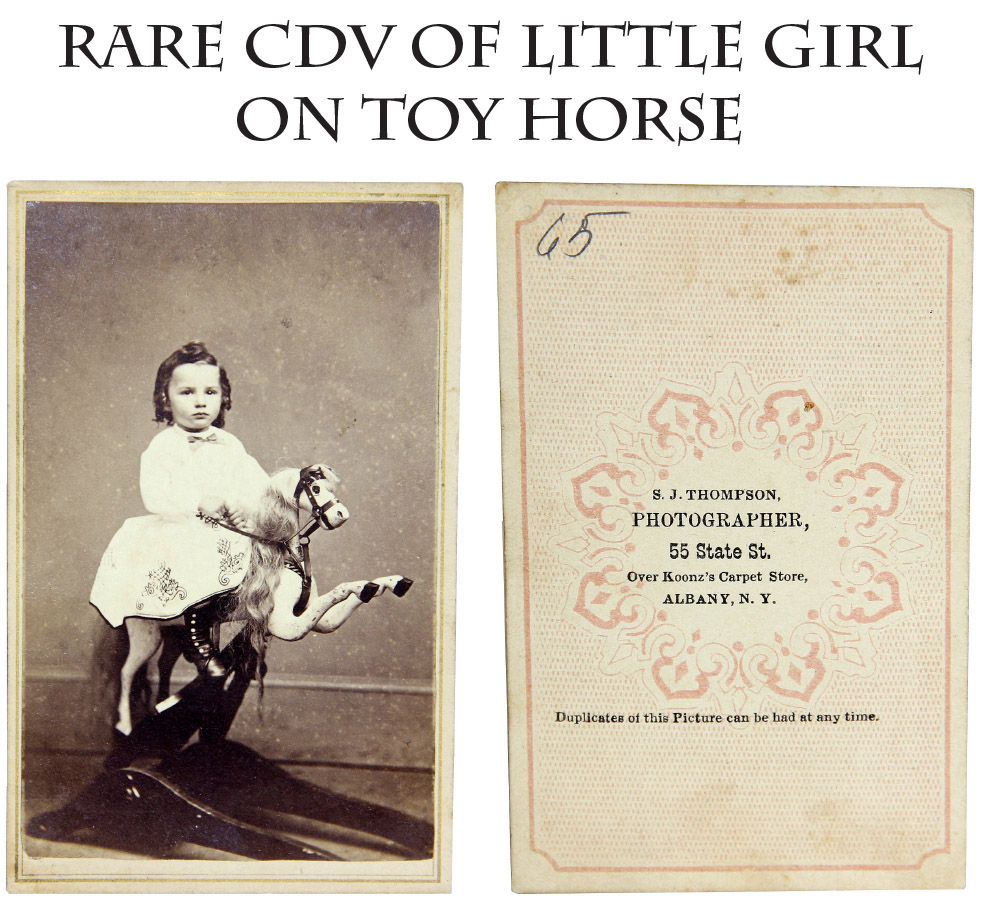
15-11-52 … Rare CDV of Little Girl (?) on a Toy Horse …
S.J. Thompson, Albany, backmarked carte de visite format albumen of a young child on a toy rocking horse. Young boys and girls were often dressed and coiffed alike during the period, but this seems to be a young girl posed on her favorite toy. Wonderful clarity and a great pose with the child looking a little serious, as if she really had to keep the rearing mount under control. Also, a bit of a telling reminder of how important it was to parents to preserve an image of their children in the days of high infant mortality. A very sentimental portrait. Excellent in all respects … fe
… $135.00
Click Here to E-mail Us!
Call us @ 419-842-1863
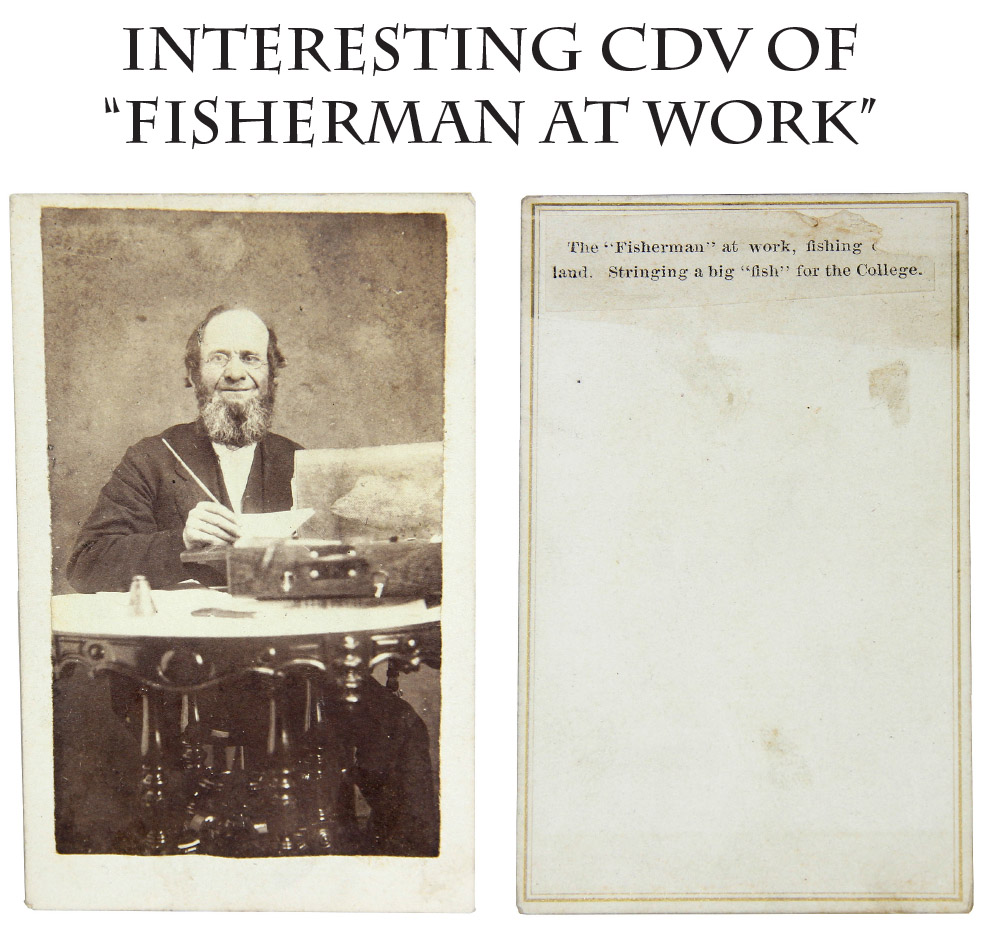
15-11-53 … Interesting CDV of “Fisherman at Work” …
Photos of people smiling during this period are very unusual. Portraiture by photography was regarded by many as a formal presentation of oneself to the world with no room for frivolity. This fellow, however, was happy in his work: “The ‘Fisherman’ at work, fishing on land. Stringing a big “fish” for the college,” according to the printed caption pasted on the reverse. This cheerful bearded fellow sits a marble top table with inkwell close to the camera and pen in hand, apparently writing a letter on a portable writing desk he has set out on the table. Fitting the printed caption is a portrait of a fish on the lid of his writing box, that he displays for the camera. The allusion to being “a fisher of men” seems pretty clear and the reference to a college then implies a religious institution, though “stringing a big ‘fish’ for the college,” may refer to securing a donor for a school or something of that sort. If he is, indeed, an educator it might be possible to identify him. The printed caption suggests there are more images of him out there. There is a good story here in any case and it’s an intriguing and entertaining photo … ee
… $135.00
Click Here to E-mail Us!
Call us @ 419-842-1863

15-11-55 … Extremely Scarce / Inscribed / Identified 21st Indiana Civil War Merrill Rifle w/ Steel Patch Box …
The Merrill rifle is one of the scarcest Civil War breech loading rifles and is not frequently seen on the market. These inscribed examples are darn near Holy Grails in the world of CW weapons. Only 800 or so rifles were made in total by James H. Merrill in Baltimore using the same system he patented for his carbines. These rare inscribed 21st Indiana examples are but a fraction of that already tiny supply made in the first place. The U.S. government bought 770 of them, issuing them to the 21st Indiana, parts of the 7th and 10th Michigan, 4th Arkansas, and the 1st Massachusetts. Some members of the companies H and K of 21st Indiana also privately purchased the weapon, and often had their names engraved on the trigger guards. This is one of those ultra rare inscribed rifles.
This one is clearly engraved “H.H. Olds,” who is listed as Harrison (aka Henry) H. Olds of Martinsville, Indiana, a member of Co. K of the 21st Indiana, which later became the 1st Indiana Heavy Artillery. (My personal guess is that Olds’ birth name is Henry Harrison Olds for reasons explained below.) Olds enlisted on 7/24/61 and mustered in as a corporal in Co. K of the 21st the same day. The regiment first saw service on the eastern shore of Maryland, but then took part in the coastal expedition and was at the reduction of Forts St. Philip and Jackson, and remained in the Department of the Gulf. It took heavy casualties at Baton Rouge, reported fighting against a Confederate brigade for three and a half hours, losing 126 men in the process. The unit was redesignated heavy artillery in February, 1863, and fought at Port Hudson, Bayou Teche, the reduction of Fort Morgan, and other engagements. Olds was promoted to 2nd Lt. 6/26/63 and 1st Lt. 3/30/64. This latter appointment lists him as “Henry H. Olds,” note the change from his 1861 records from first name Harrison to Henry… hence my theory that H.H. Olds birth name is Henry Harrison Olds. He served until discharged 6/11/65.
Olds’s rifle has matching serial number 1572. All bands, swivels, sights, bayonet lug and rod are in place. Steel surfaces are grey with hints of plum and some very fine surface texture pitting. Some minor dings to the upper surface of the loading assembly and light pits to the hammer. Clear patent markings on the top of the lever and clear lockplate markings. The lockplate is dark, and shows a cloudy blue patina. Very slight rounding to the lock apron, one depression above the forward edge. Some dark staining to the wood around the patchbox cover, which is a steel patchbox as opposed to brass. Extra nipple is in place inside patchbox. The long Merrill side plate is also steel, as opposed to brass. Bands are brass. A small number “47” on the nose cap is likely Olds’s rack number. A very scarce and desirable breechloader, especially so with a personal identification to the soldier. Here is a synopsis of the unit’s history …
Originally organized in July 1861 as the 21st Indiana Infantry armed with Enfield rifles, the unit left the State for Baltimore, Md., July 31, and was on duty in the defenses of that city until February 19, 1862.
Attached to Dix’s Division, Baltimore, Md., to February 1862.
Butler’s New Orleans Expedition to March 1862. 2nd Brigade, Dept. of the Gulf, to October 1862.
Independent Command, Dept. of the Gulf, to January 1863.
Unattached, 1st Division, 19th Army Corps, Dept. of the Gulf, to February 1863.
Designation changed to 1st Regiment Indiana Heavy Artillery, February 1863. Artillery, 1st Division, 19th Army Corps, to August 1863.
District of Baton Rouge, La., Dept. of the Gulf, to June 1864.
Unattached, 19th Army Corps, and unattached, Dept. of the Gulf, to January 1866.
Expedition to Eastern Shore of Maryland, November 14-22, 1861.
Moved to Newport News, Va., February 19, 1862; thence sailed on Steamer
Constitution
for Ship Island, Miss., March 4-13.
Duty at Ship Island till April 14. Operations against Forts St. Phillip and Jackson April 14-28. Occupation of New Orleans May 1 (first Regiment to land).
Camp at Algiers till May 30.
Expedition to New Orleans and Jackson R.. R. May 9-10.
Moved to Baton Rouge May 30, and duty there till August 20.
Battle of Baton Rouge, La., August 5.
Evacuation of Baton Rouge August 20.
Camp at Carrollton till October.
Action at Bayou des Allemands September 4-5.
Expedition from Carrollton to St. Charles Court House September 7-8.
Skirmish near St. Charles Court House September 8.
Expedition from Carrollton to Donaldsonville and skirmish October 21-25.
Duty at Berwick Bay until February 1863.
Bayou Teche November 3, 1862.
Action with Steamer “Cotton” Bayou Teche January 14, 1863.
Operations in Western Louisiana April 9-May 19.
Teche Campaign April 11-20. Fort Bisland April 12-14.
Advance on Port Hudson May 20-24.
Siege of Port Hudson May 24-July 9.
Assaults on Port Hudson May 27 and June 14.
Lafourche Crossing June 20-21 (Co. “F”).
Brashear City June 23 (Co. “F”).
Expedition to Sabine Pass, Texas, September 4-11 (Detachment).
Garrison duty at New Orleans, Baton Rouge and at various points in the Dept. of the Gulf till February, 1865.
Companies “L” and “M” organized August 12 to November 2, 1863. Red River Campaign March to May, 1864 (Cos. “G” and “II”).
Blair’s Landing April 12-13 (Detachment). Monett’s Ferry, Cane River Crossing, April 23 (Detachment).
Retreat to Morganza May 13-20.
Operations in Mobile Bay, Ala., against Forts Gaines and Morgan August 2-23 (Cos. “B,” “F,” “H” and “K”).
Siege and capture of Fort Gaines August 3-8.
Siege and capture of Fort Morgan August 8-23.
At New Orleans, La., till March, 1865.
Campaign against Mobile, Ala., and its defenses March 17-April 12, 1865.
Siege of Spanish Fort and Fort Blakely March 26-April 8.
Fort Blakely April 9.
Occupation of Mobile April 12, and duty there till June 24.
Garrison duty till January, 1866.
Companies “B” and “C” at Fort Morgan, “H” and “K” at Fort Gaines, “F” and “L” at Barrancas, Fla.; “I” and “M” at Fort Pickens, Fla.; “A,” “E” and “G” at Baton Rouge, La., and “D” at Port Hudson, La.
Mustered out at Baton Rouge, La., January 10, 1866
… EXTREMELY RARE AND VERY HISTORICAL … $6,750.00
Click Here to E-mail Us!
Call us @ 419-842-1863
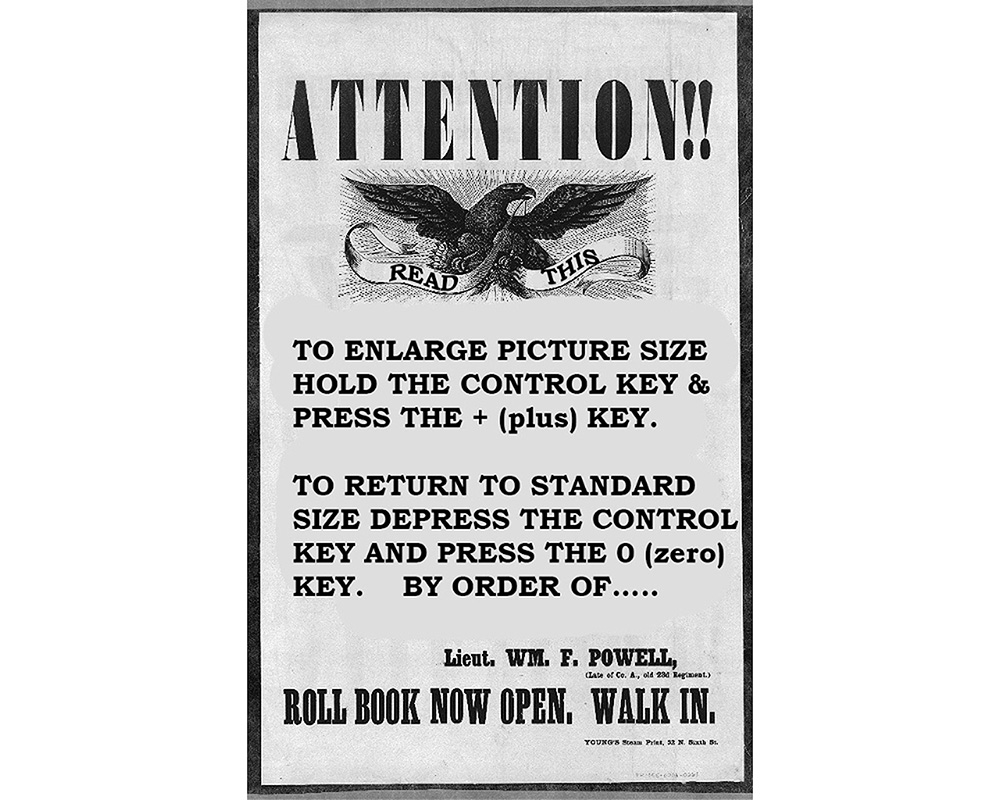
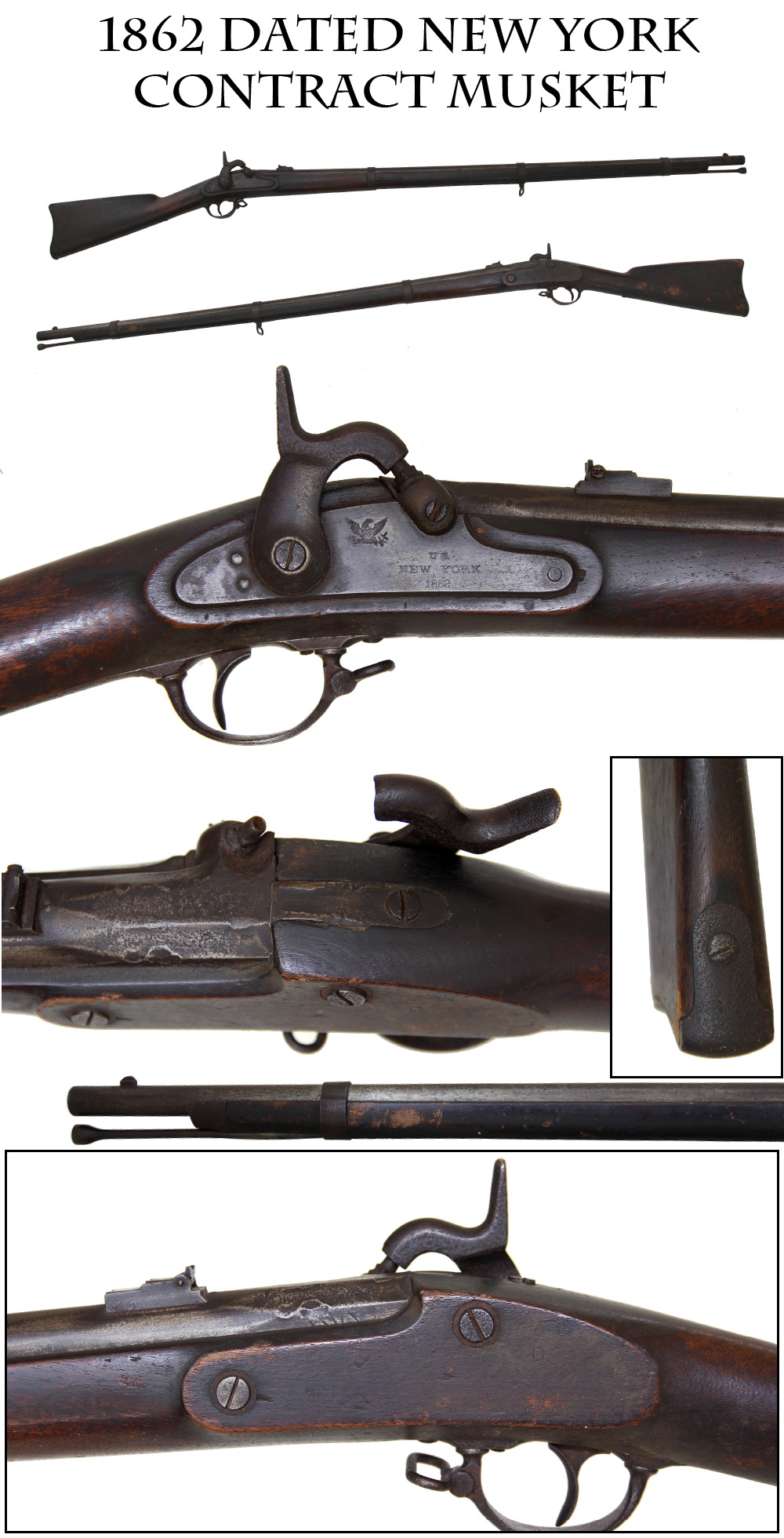
15-11-56 … 1862 Dated Sarson & Roberts “New York” Contract Rifle Musket …
Very scarce 1861 contract rifle musket made by Sarson and Roberts of New York. One of the truly “hard to find” muskets. Sarson and Roberts sub contracted most of the parts for these muskets to Albert Jenks and Son in Philadelphia. When all was said and done they only managed to supply 5,140 completed arms to the government in 1862-63. This is an incredibly small production run for a musket contractor. Our musket has very clear lock markings of an eagle just to the right of the hammer and “US” over “New York” above an “1862” date. Good edges on the wood around the lock and on the offside. Has a few minor scuff marks here and there. The breech area shows some light corrosion from percussion caps. There are some obvious vise marks on the breech and breech plug tang. Steel surfaces are mostly age brown patina mixed with grey. Butt plate shows some pitting from standing on a damp floor. Sights, bands, springs, swivels and rod all in place. The rear sight is the early 1855 1861 short range sight with the “back porch” on it. Mechanically very good. A nice early-war 1861 contract from a hard-to-find maker. These “New York” contract muskets were rare in 1863. They saw hard service all through the war, and very few survive to the present time. This is a darn nice example of a darn scarce contract …
aa-ck-150322
… $1,795.00
Click Here to E-mail Us!
Call us @ 419-842-1863
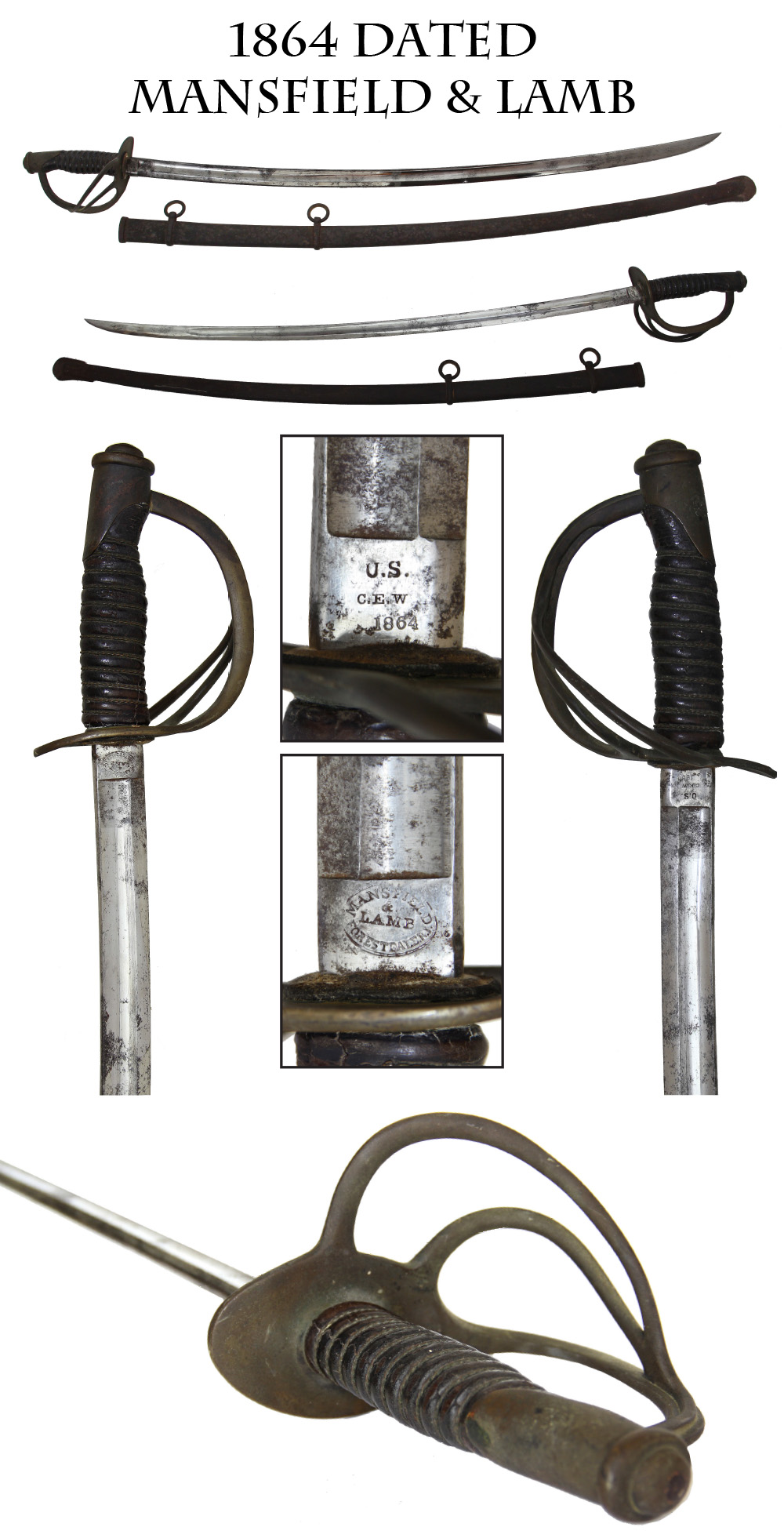
15-11-57 … 1864 Dated Mansfield & Lamb …
Standard Union army issue light cavalry saber. US/C.E.W/1864 is clearly stamped on one side of the ricasso of this Model 1860 cavalry saber, and “Mansfield & Lamb/ Forrestdale RI” in an oval is on the other. Made in time for some of the toughest cavalry fights and raids, this saber has a bright blade with most of the original bright factory polish still present. There are a few age spots. Has a good clean edge and a good point. The leather pad is still present under the guard and the grip has nearly all of the original leather and the original wire in place and tight. The brass has a nice untouched, aged patina. The scabbard has throat, drag and rings in place and is “in the brown” (has a rust brown patina) with moderate pitting on the drag. A nice untouched cavalry side arm the way we like to find them: un-messed with, just brought home by a soldier and put away. The essential piece in a cavalry collection. Much nicer than most we see. The blade is outstanding … fej-hal-130907
… $795.00
Click Here to E-mail Us!
Call us @ 419-842-1863
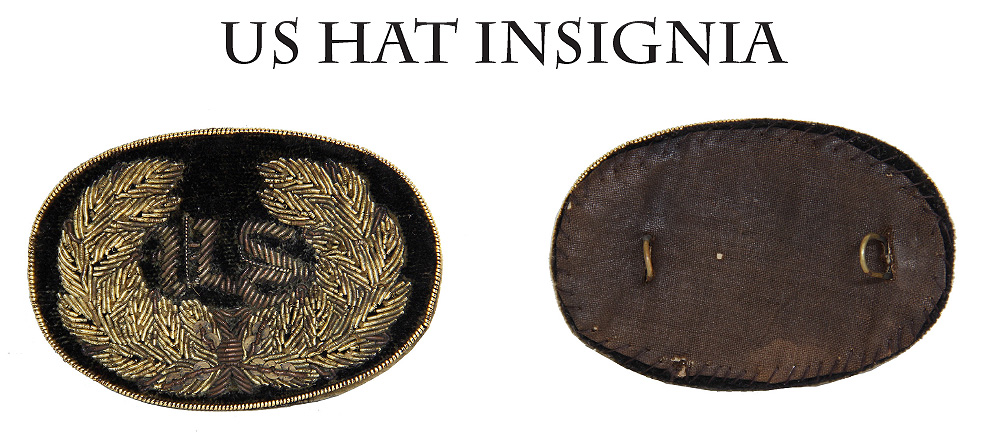
15-11-58 … U.S. Oval Hat Wreath Insignia …
Very nice condition regulation Civil War US officer’s hat insignia consisting of an embroidered silver US in Old English surrounded by a gold wreath with jacqueron wire border. Deep blue/black velvet background. This is the most desirable style, being stitched over a thin metal plate for stiffness with a polished cotton back and two brass loops protruding to mount it on a slouch hat. Nice color, nicely age toned. A striking piece of insignia for wear by officers on staff duty and general officers. Measures 3 inches by 1 78ths inches. Getting darn scarce. I paid darn close to this price just to get it …
eej
… $665.00
Click Here to E-mail Us!
Call us @ 419-842-1863
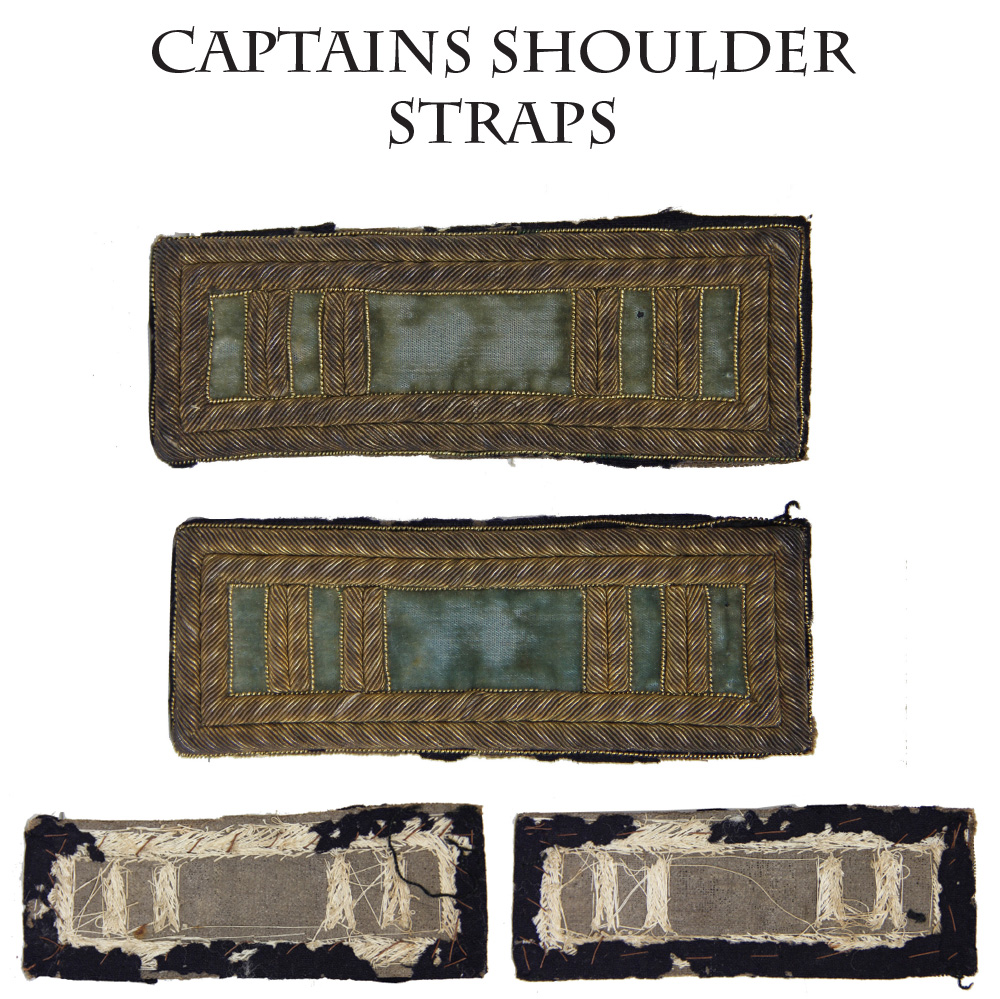
15-11-59 … Large Size Double Bordered Infantry Captain’s Bullion Shoulder Straps …
Military goods dealers offered insignia to officers in many different grades appealing to different tastes and budgets. Here’s a nice higher quality set of infantry captain’s straps with a light blue velvet background and double rows of gold bullion embroidery, bordered by jacqueron wire, both for the borders and the interior bars. Some light wear to the nap and mellow toning to the bullion. Very pleasing not oxidized as we frequently see. Open “raw backs”, as is most typical for Civil War straps. There is some mothing to the dark blue wool that makes up the extreme edges and backs of the straps. This is mentioned for accuracy as the dark blue wool is barely visible when displayed or sewn to a coat. Most of the mothing is on the back. A nice set worthy of a good bullion insignia collection. I gave 700 and am getting rich selling at …
zwgjj
… $795.00
Click Here to E-mail Us!
Call us @ 419-842-1863
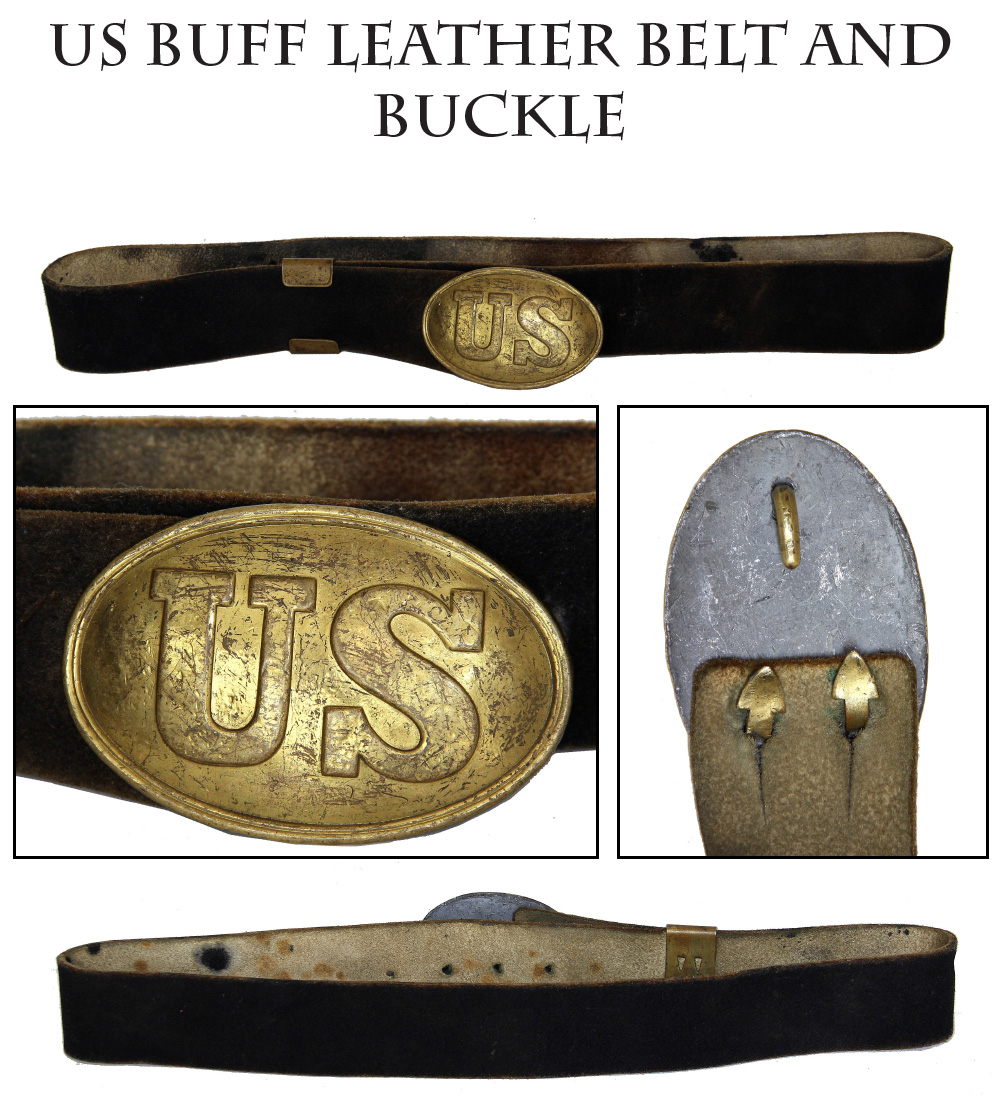
15-11-60 … Buff Leather Infantry Waist Belt …
Regulation US infantry belt and plate. I may be showing my age, but I remember when Bernie Mitchell and George Gorman bought a mess of these out of the old H.K. White’s military goods shop. Back then lots of the “kids” wore them to reenact or skirmish with. This has the ever durable “Buff Leather”… being rougher and tougher than the standard harness leather belts we usually see. Collectors have always liked “buff” because it has held up better over the past 150 years. This is the standard rig… using the arrow hook US plate and having the brass C-clasp keeper on the leather. Issued black, these belts oxidized to brown soon after issue from iron mordants in the dyes. This one shows some minor staining to the cream color interior and various rubs to the face of the plate, which still has a lot of its original gilt. It’s a very nice example and pretty close to how it looked 150 years ago. Still flexible, and worth setting up with a comparable cap box and scabbard to make a complete infantry outfit. I had to pay 425 so I can sell it to you for …
dbe
… $495.00
– SOLD
Click Here to E-mail Us!
Call us @ 419-842-1863
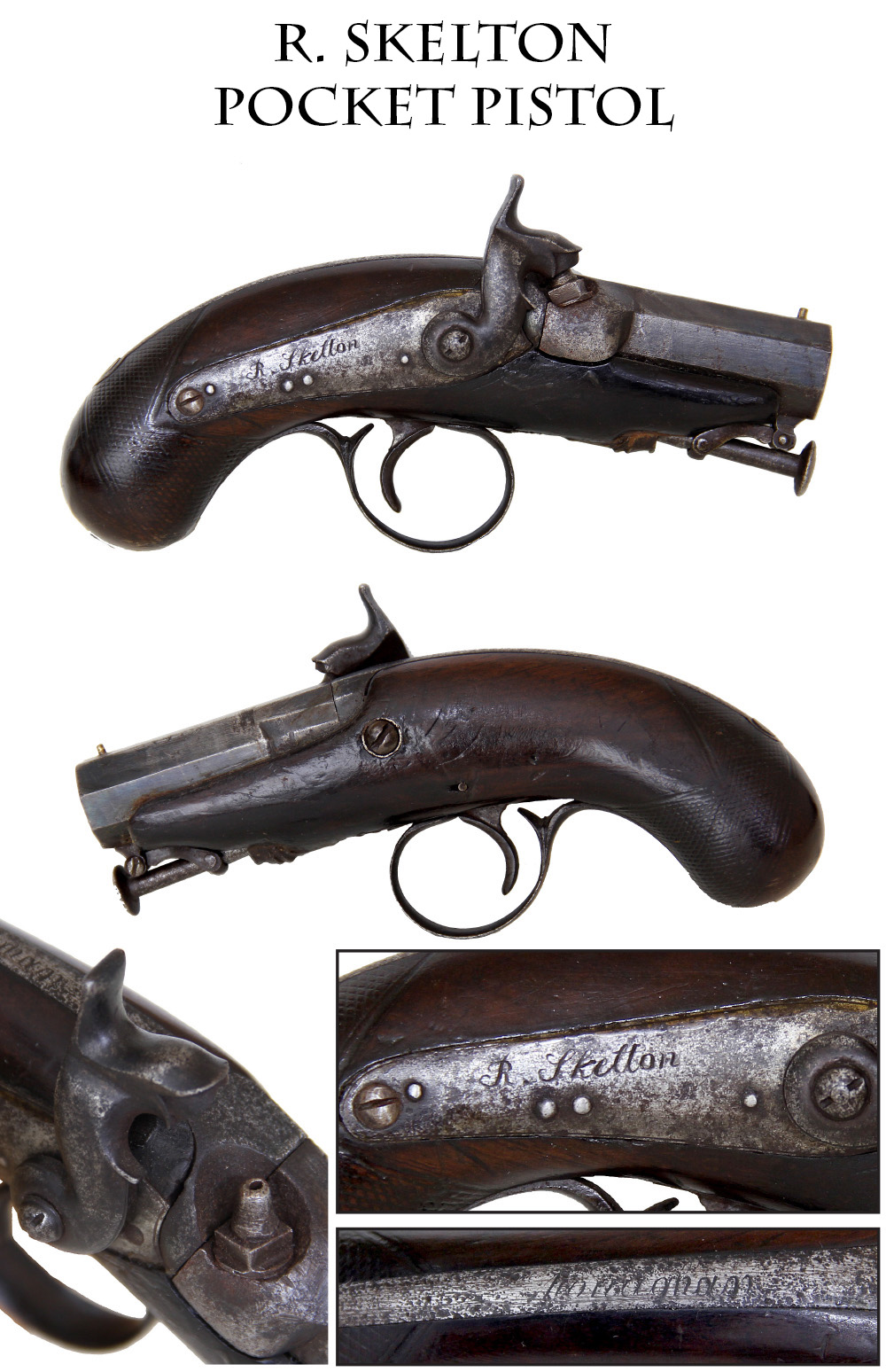
15-11-61 … Irish Percussion Deringer Style Pocket Pistol By Skelton …
This large bore pocket pistol closely resembles our own Deringers, but the maker “R. Skelton” on the lockplate and an owner’s name, “Monaghan” engraved on the backstrap make it likely we are looking at an Irish product. Short 2 ½ inch octagonal barrel with a checkered bag shaped grip. Mottled silver and gray on the lockplate, muted blue on the barrel. Stock has wood filler and shellac under the bolster and forward of the trigger guard. You don’t really notice it, but it’s there. Retains its’ captive rammer fully intact.. Mechanically very good. A pocket version of a “man-stopper.”
… exbun
… $495.00
– SOLD
Click Here to E-mail Us!
Call us @ 419-842-1863

15-11-62 and 15-11-63 … 2 Import French Light Infantry Shakos Awarded By McClellan in 1862 …
French Model 1860 Military Shakos imported as part of 10,000 complete chasseur, or light infantry uniforms, for issue to Union troops. McClellan issued them to the best drilled regiments and they went to the 83rd Pennsylvania, 18th Mass., and 72nd New York among others. The Shakos are black leather with leather “V” shaped reinforcements on either side and leather bands reinforcing the top and bottom. The short visor is black. The brass cap plate depicts an American Eagle with outstretched wings sitting atop crossed cannons and arrows and an olive branch which encircles an infantry bugle. The red, white and blue national cockade, which is above the cap plate, is present on our left example, but missing on the right. These were equipped with plumes as well, but wartime photos show them worn by US troops with and without the plumes and sometimes without the plate as well. Vents on either side of the shako are black painted tin on the outside and brass inside – and present on both of our examples. Our right example has a brownish patina to the body of the hat, and a break in the leather around back, shown in an image above. Interior straps present in our excellent left example, are also missing on our right. You can see some damage on the left side of the visor on our left example, where none is present on the right example. On the underside of visor of said left example is the letter “D” and above that a number “7” … the right example features a letter “G” in the same area and the number “5” inside the hat. We show images of Union soldiers wearing these from Langellier and Loane’s book on headgear and a shot of bandsmen of the 9th VRC, who later drew them from government stocks. A real piece of Civil War headgear. Either would be a great addition to a collection and each is priced easy….
15-11-62 … Excellent Example Shako (hat on left)
…
noco
… $595.00
– SOLD
15-11-63 … Good Example Shako (hat on right)
…
noco
… $395.00
– SOLD
Click Here to E-mail Us!
Call us @ 419-842-1863

15-11-64 … Outstanding Spanish Miquelet Flintlock Pistol With Belt Hook …
Ca. 1760-1780 … Dating Spanish arms can be tricky. They were pretty conservative in their styling and the Spanish liked the miquelet lock so much that it even was reintroduced in military arms around 1790. This pistol has the classic Miquelet elongated jaws, ring jaw screw, and frizzen with vertical ridges. The silver wire inlay around a large oval escutcheon on the wrist looks early. The British style trigger guard and tang are classic late 18th century. Brass ramrod ferrule, side plate trigger guard and butt cap with long spurs. The very tip of the butt cap is a separate silver piece engraved with floral motifs. The silver matches the escutcheon plate, which has an engraved border. All of this marries wonderfully with the bright metal of the barrel and breech plug tang, the latter of which is also engraved. Raised floral carving in the wood around the apron links the escutcheon plate and breechplug tang from a design point of view. The barrel has a gently flared muzzle and is two-stage: octagon going to round, with a transitional ring midway along the barrel. Deeply struck barrel proofs and maker’s mark along with inlaid crosses and orbs. The barrel markings are wonderful, but I will leave the research of what they mean to you. Very nicely done iron belt hook on the left side terminating in an open heart. The ramrod looks old, though perhaps not fancy enough to be the original. Stock has some significant wood repair. The forend on each side of the barrel has repaired cracks and replaced wood. There is some filler and shellac around the edges of the lock… well done. Otherwise VG. (see photo) One heck of a fine early Miquelet pistol. 8 inch barrel 14 inches overall …
gej
… $1,850.00
– SOLD
Click Here to E-mail Us!
Call us @ 419-842-1863

15-11-65 … Gettysburg Letter and Tintype .of Charles R. Crimble of Custer’s 5th Michigan Cavalry …
In Civil War collecting it doesn t get much better than Gettysburg or Custer. Put them together and you have a very rare item. I owned this tintype and a large number of the soldier s letters years ago. Since then collectors have divided the group, but the tintype and Gettysburg letter have stayed together. The soldier is Charles Crimble of Co. B. The letter is datelined Picket Reserve near the Rappahannock Virginia July 28th 1863 and is addressed to Friend Martha. He opens with a description of the pursuit of Lee s army after Gettysburg, comparing the Fourth of July fireworks at home with a fight at Monterrey, Maryland, on the night of July 4, He has his own way of spelling . they artylery throughing shell and our rifles sending they misives of Death.. and the destruction of Ewell s wagon train (spelled Uwell ), which took place at Williamsport later in the pursuit. He dismisses rumors they were driven to Washington: there is not a rigiment in the miserable Confederacy that can drive us or a Brigade. We are willing to fight them 3 to 1 any day we have fought them 6 to our one and beat them we did it at Williamsport and Boonsboro He notes the regiment is down to about 400 men and that he himself has been in ten battles and had close calls two or three times.
His account of Gettysburg is great: they most terifick Cannonading I ever heard or ear tell of. They Battery men said that Fredericksburg was only a little skirmish beside that and Bull run was nothing compared with it. they last day it commenced at 1 oclock they opned 250 pieces of artillery on our right wing and center and tehn charged with bassed coloums (massed columns) and ours opened with about the same number and it last till 15 minutes a past three they shells bursted a hundred at they time. I sit on my horse all they time waching for there Cavalry to pitch in as well and at 3 oclock they commenced and then it was awful they firing and yeling when they made a charge with drawn saber was a terible sight I never want to see another such in my time we lost one major killed there [referring to Major Noah Ferry] and I don t know many killed and wounded men He goes on to mention his captain is acting major and Bigelow (referring to Lt. E. Bigelow of Co. B) is commanding Co. B, etc. He closes with the note that he is living on the top shelf at the moment since he is acting as the captain s cook, but adds, you would not no us now we are a rough looking lot of men.
The tintype is a sixth plate showing Crimble full standing, wearing a mounted jacket with gilded buttons, shoulder scales and belt plate on his saber belt. He holds the saber unsheathed at one side with its saber knot hanging down and has a revolver holster at his side. There are some rub marks and stains, but the image is still very good. Custer and Gettysburg need no elaborate descriptions. Nor does the Michigan Cavalry Brigade. This was one of the most famous fighting outfits of the war. A very historic pair. You are not likely to get a similar chance
… $2,250.00
Click Here to E-mail Us!
Call us @ 419-842-1863

15-11-67 … Extremely Scarce 1839 Pattern Rifleman’s Pouch With Batty Flask …
These rare 1839 rifleman s rigs consist of a wide shoulder belt split into two straps at each end to hold the leather bullet pouch and brass powder flask. These were intended for use with the 1817 Common Rifles, and the Hall rifles. They remained in service well into the 1850s in the hands of militia companies armed with a variety of rifles. This is in extraordinarily nice condition, with complete, unbroken flexible straps, and shoulder belt, dyed black. The flask is a darn nice peace flask by Batty dated 1847 with the marks clear, a nice mellow patina, no dents, full spout and operable spring. The pouch, too, is seldom seen in this condition: nice finish to the leather, smooth and flexible, loops for the shoulder belt still secure on the reverse. An old painted number on the inside of the belt is probably a rack number. There is a small tear on one edge of the cover fold line; the latch tab has split on one side of the fastening hole; and the leather knot acting as a button has come untied. These are extremely minor faults on a rig this nice and could be repaired easily. As it is, it is one of the best examples I have seen in many years
… $2,650.00
– SOLD
Click Here to E-mail Us!
Call us @ 419-842-1863
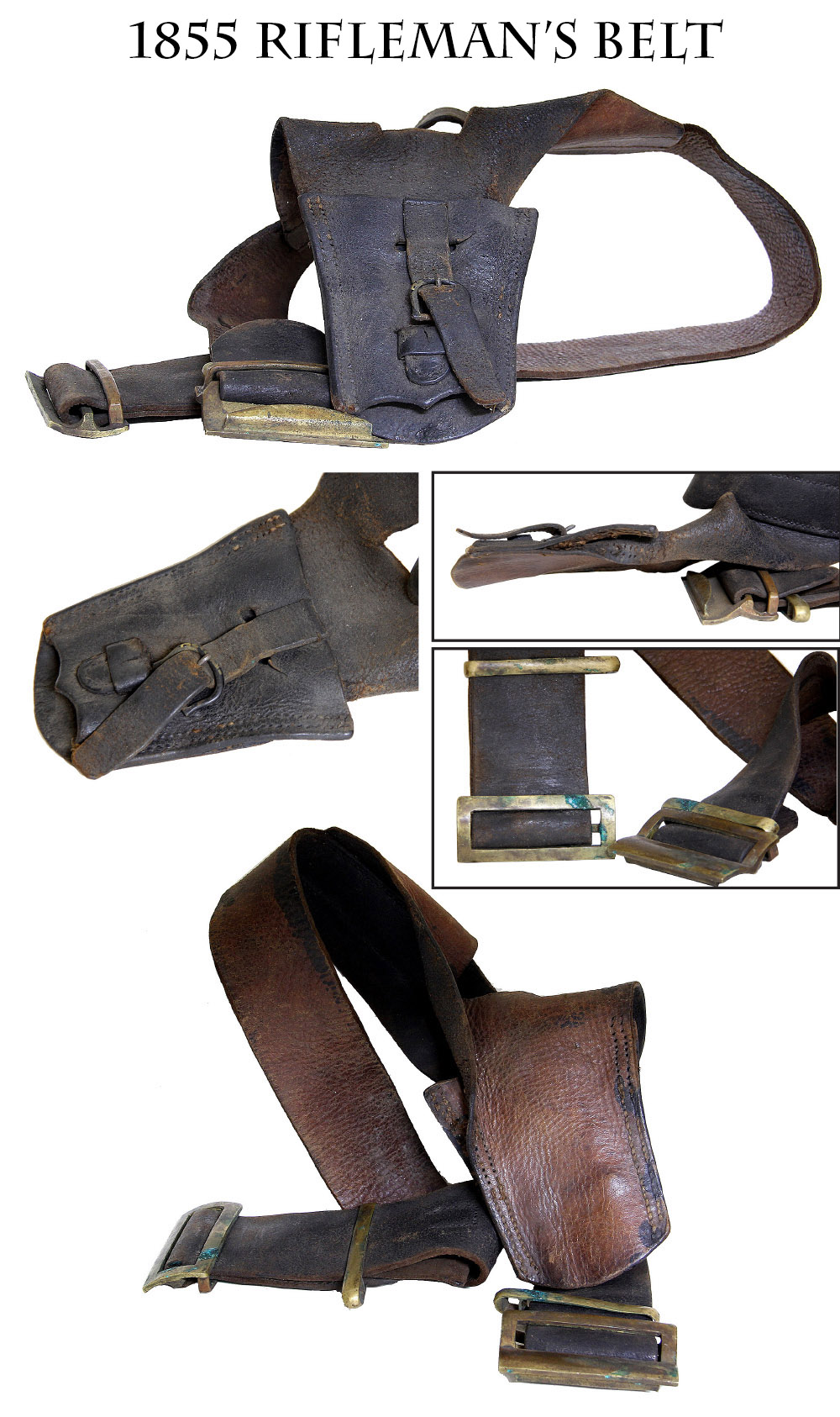
15-11-68 … Rifleman’s Belt …
US Model 1855 Rifleman s Belt and Bayonet Frog with four piece buckle. Purchased by an old time collector from Bannerman s in the 1940s, they advertised it as a Confederate Army Officer s Sword Belt way back when. This is a VG+ black harness leather example. 100% complete but the roller buckle on the frog has pulled loose and some side stitching in the frog has popped. I will let you fix these little leather issues. These were issued with Model 1855 rifles and other two-band short rifles that accepted the saber bayonet. The buckle is rather ingenious having the central interlocking buckle and then two flanking devices designed to hold the brass hooks of a knapsack. Overall real good being a little dirty from years of storage. The tourist town dealers have been pricing these in the $1300 to $1600 range … Here is a heck of a deal
… $795.00
– SOLD
Click Here to E-mail Us!
Call us @ 419-842-1863
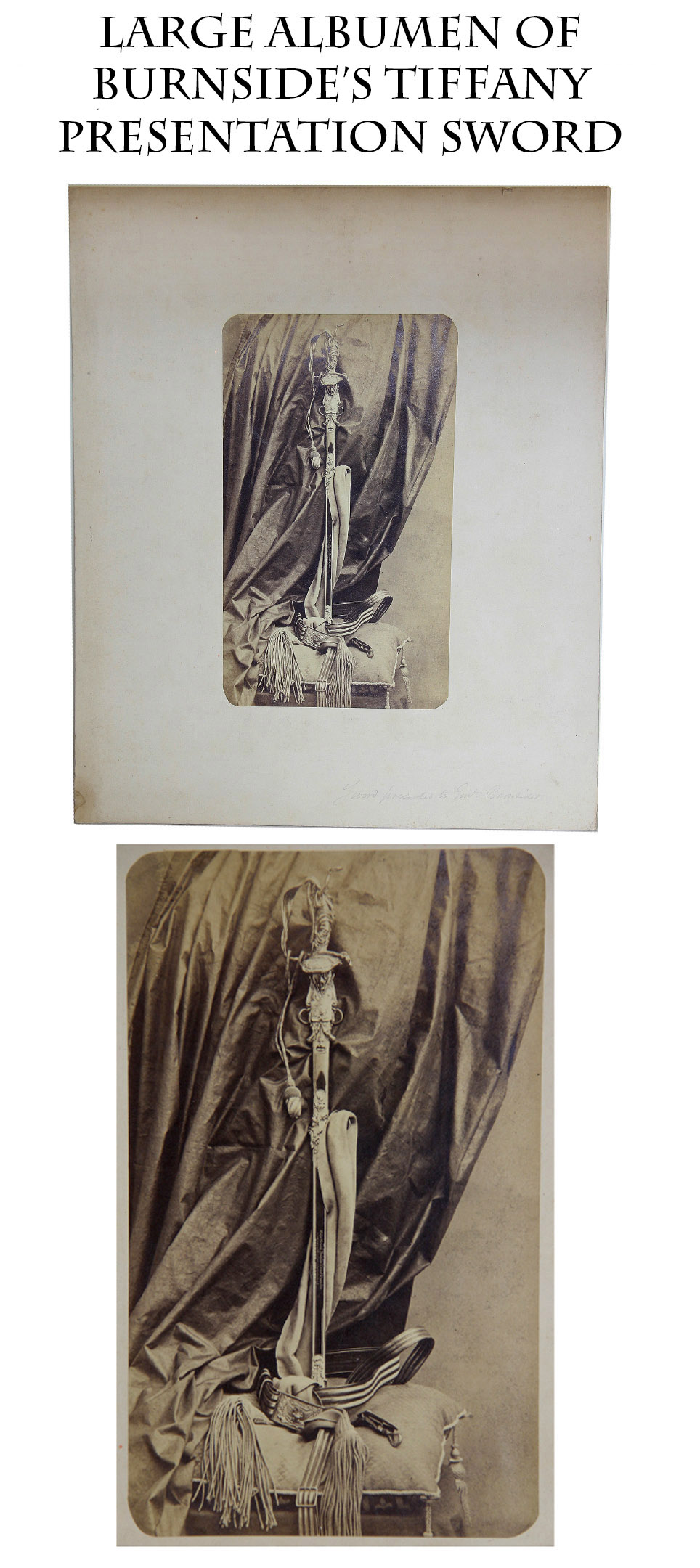
15-11-69 … Large Format Albumen of a Tiffany Sword Presented to General Burnside …
Wonderful photo showing a statue hilted sword presented to General Burnside, along with sword knot, sash and general officer’s belt laid out on a pillow. Presenting swords to famous generals was longtime tradition and commemorating the gift with a photograph was a good bit of publicity for the giver and the sword maker. This photo shows a magnificently detailed officer’s sword with a figure of the goddess victory or perhaps the personification of Columbia raising a victor’s wreath in her right hand. The scabbard mounts are as heavily worked as the grip. The upper mount is topped by a display of flags and a trophy of arms. It is one heck of a sword, worthy of a better recipient in my opinion. Burnside was regarded at the time as being the ideal image of a soldier, and he had some early successes, but that opinion probably did not survive anywhere after his disastrous defeat at Fredericksburg. Let’s hope the presenters did not ask for the sword back. In any case, it’s a magnificent piece. I don’t know where it is now. The wooden presentation case for this sword reportedly surfaced in France a few years back, and is now in a Pennsylvania collection. It bore a wonderful presentation plaque, but there was no sword in it. The sword is still amazing, even if only in a photo. This would make a wonderful display piece if you like high-end swords
… $595.00
Click Here to E-mail Us!
Call us @ 419-842-1863
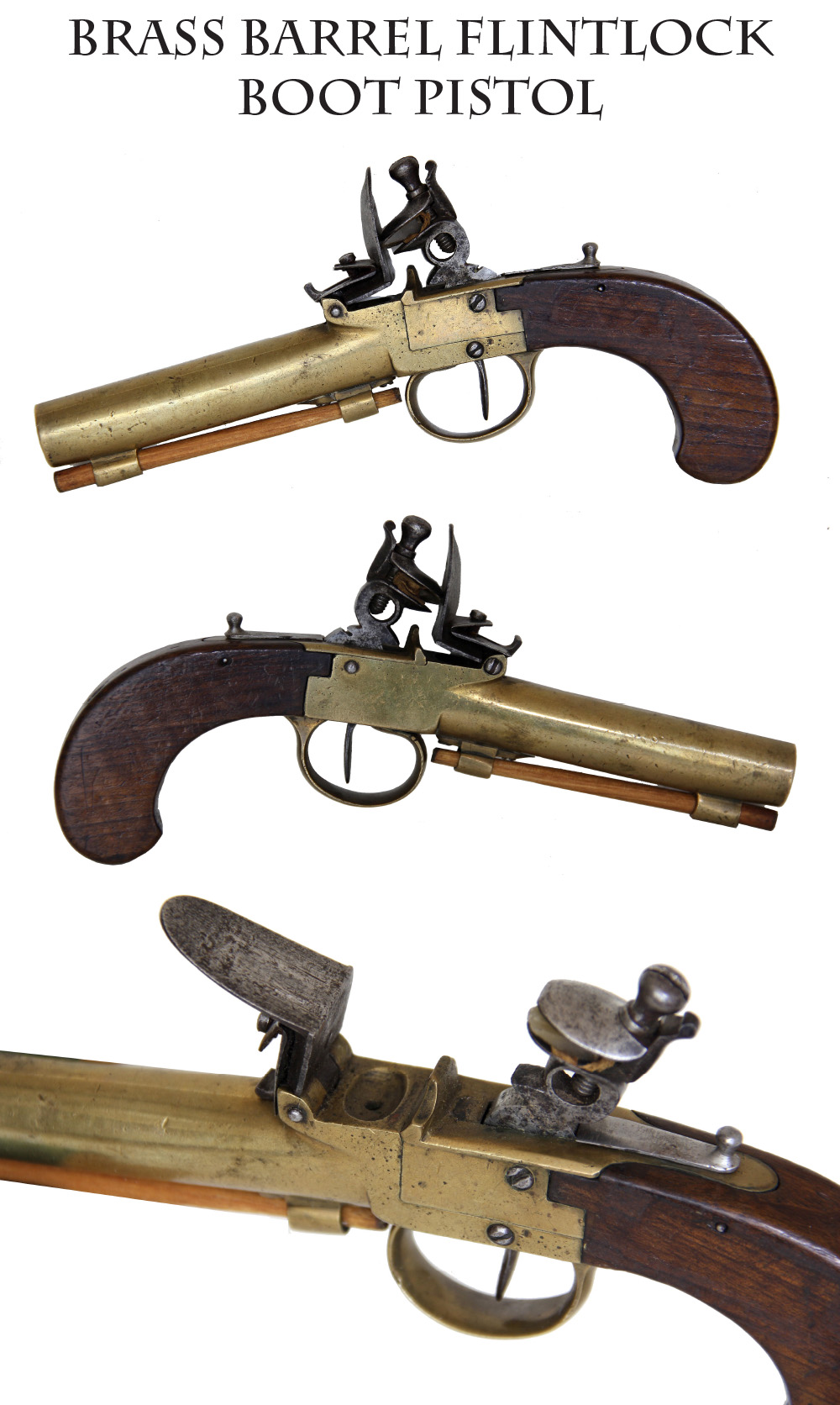
15-11-70 … Brass Barrel Flintlock Pocket Pistol …
Roughly 50 caliber. 4 inch barrel. 8 inches overall. This unmarked pocket pistol dates to about 1820 and was designed for carrying when out and about, though some military and navy men kept them in a pocket as a last ditch weapon. Modeled on the early Queen Anne style pistols, this one has plain, flat-sided grips, a center mounted hammer and rear sliding safety catch. The wood is excellent. The brass frame and barrel are smooth and have a nice patina, the barrel a touch lighter than the frame from handling. Also distinct from the earlier versions of the pistol is the fixed barrel with a ramrod secured below the barrel by two brass thimbles, where the earlier versions featured a “turn-off” barrel loaded from the breech. About 50 caliber, this small pistol would carry wallop at close range. Early, handsome, affordable
… $595.00
– SOLD
Click Here to E-mail Us!
Call us @ 419-842-1863
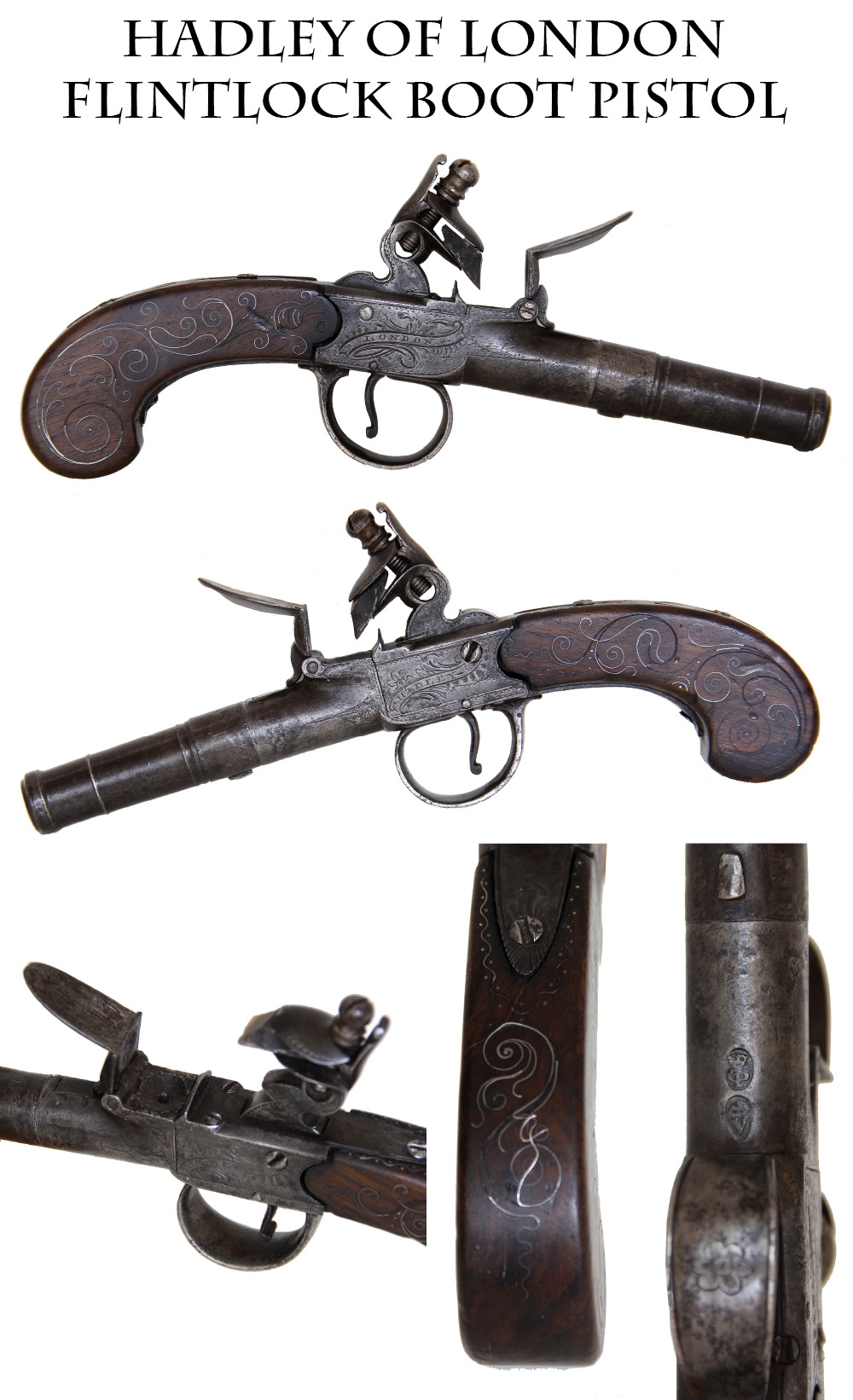
15-11-71 … Wire Inlaid Flint Pocket Pistol by Hadley …
Roughly 45 caliber. 7 inches overall. Screw-off barrel is 2 inches when removed but is effectively 4 inches when screwed onto the breech section which is milled as part of the frame. Similar to the brass barreled pistol offered above, this iron mounted version is a tad earlier and a bit fancier. The grips are also flat sided, but preserve the old style silver wire inlet in rococo swirls. Either side of the frame is engraved with foliate flourishes and a central ribband reading Hadley on one side and London on the other. Simple flower decoration on the trigger guard. View and proof marks on the underside just forward of the trigger guard. Narrowing cannon barrel with a muzzle ring. Gray tones to the metal overall with some faded plum towards the muzzle. Some losses to the silver wire, but the patterns are distinct. No top mounted safety. Probably about 1790. A nice example
… $595.00
– SOLD
Click Here to E-mail Us!
Call us @ 419-842-1863
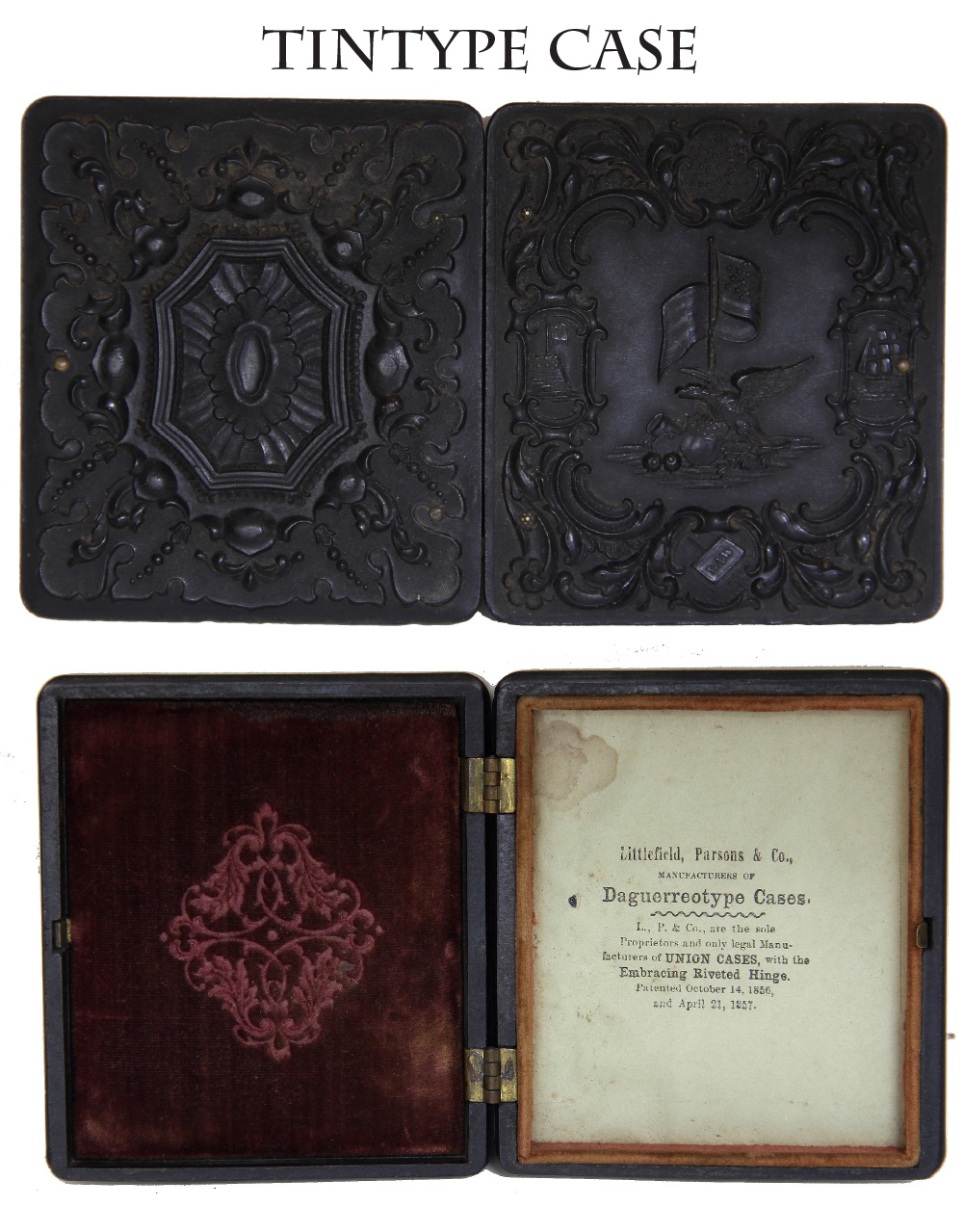
15-11-72 … Sixth Plate Patriotic Thermoplastic Daguerreotype Case …
Hard image cases with molded designs became very popular in the 1850s. This one is in great shape, still has its velvet facing pad and its Littlefield, Parsons & Co. maker’s advertising label inside and is ready to house a 6th plate image. The back of the case is a geometric design. The front has a central motif of an eagle perched next to a mortar and stacked cannonballs with a flag flying overhead, a star of stars at the top of a floral border, a sign reading “law” below, on the left a fortress flying a flag, and on the right a sailing ship (entering the harbor guarded by the fortress.) The hinges are good on this case, not wobbly, it closes and opens crisply and it has little wear to the edges. Perfect to house one of your better tintypes… or to simply display closed showing the patriotic art of the period
… $195.00
– SOLD
Click Here to E-mail Us!
Call us @ 419-842-1863

15-11-73 … Tintype od a Double Armed Officer Showing Off His Sword …
Very clear sixth plate tintype with matt, glass and frame, just some shading around the periphery, not affecting the subject. Our man is an infantry line officer: the bugle on the front of his forage cap shows clearly and he wears a single-breasted frock with shoulder straps that seem to bear captain’s or lieutenant’s bars. He wears sword belt with shoulder strap and one end of his officer’s sash is shown and is delicately tinted. Tucked in his belt is a 36 caliber belt revolver… not a Colt … would need to research more to identify it. Best of all, he wears a pair of gauntlets and is holding his foot officer’s sword forward for the camera. The message is pretty clearly, “I got my commission and here’s my sword to prove it.” Some light gilt touches by the photographer to the brass elements. It would display particularly well in a sword collection. A dandy …
bej-mgrac
… $395.00
– SOLD
Click Here to E-mail Us!
Call us @ 419-842-1863

15-11-84 … Very Nice 1851 Sword Belt Plate With 3 Piece Wreath …
The rectangular 1851 eagle plate, as collectors know it, was introduced for officers and for enlisted men carrying swords, that is: cavalrymen, mounted artillerymen and infantry NCOs. The enlisted plates were issued rather than privately purchased and are identified by the use of separately applied “German” (i.e. nickel) silver wreaths. This one has great color and crisp detail and is the early narrow version of the plate with the wreath made and applied in three pieces to make the eagle appear superimposed. The tongue is the long narrow style and the plate comes with its original matching hasp, or keeper. A very slight bend to the side bar shows the plate and hasp were actually worn at some point, but there is little wear evident. The only fault is a black ink or paint stain on the reverse. This could probably be removed, but is not at all evident from the front, which is what counts. A nice example of a regulation issue sword belt plate, better still with the original keeper
… $295.00
– SOLD
Click Here to E-mail Us!
Call us @ 419-842-1863
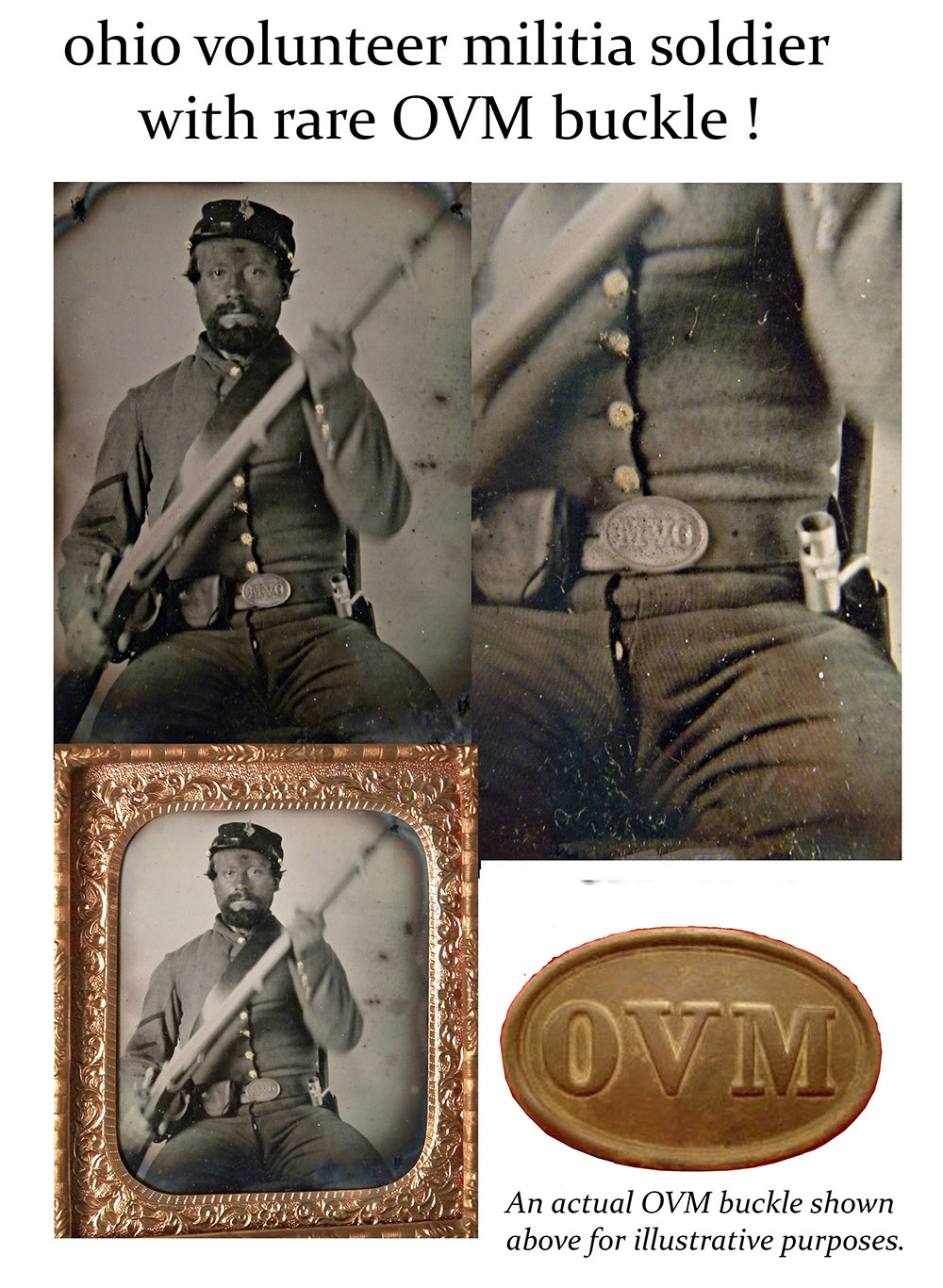
15-11-85 … Sixth Plate Ohio Volunteer Militia Soldier Showing a Super Rare OVM Plate …
This sixth-plate image with matt, glass and frame shows a very early war armed Ohio soldier holding up his cocked musket for the camera. His cartridge box sling is visible across his chest and his waistbelt carries his cap box and bayonet. Best of all, his oval “OVM” plate is sharp and clearly shown, indicating he is a member of the Ohio Volunteer Militia. Further backing up an early-war time frame is the light color of his jacket. A few low numbered units like the 15th, 17th, 19th and 20th regiments received gray shell jackets, such as this. He seems to wear a darker standard issue forage cap, but his sleeve also shows an inverted chevron, also far more typical of early-war insignia than later, which tended to mimic current federal regulations. Our man has moved his musket slightly, giving it a slight blur, but the uniform content is great, and the OVM makes it super
… $1,500.00
Click Here to E-mail Us!
Call us @ 419-842-1863

15-11-86 … Attic Brown Mexican War Dated Harpers Ferry ’42 Musket – A Real veteran …
1846 and 1851 dated 1842 pattern .69 Caliber musket. The last of the regulation .69 caliber US infantry arms and the first of the issue percussion long arms. Attic condition, brown overall, no crustiness to the metal, just patina, mostly smooth. As expected there is some roughness around the nipple from firing. HARPERS/ FERRY/ 1851 a tad light but readable on the lock behind the hammer, the eagle worn but present forward. Two light stress lines coming off the rear of lock platform, but very short and the wood is tight and has very good edges. Some abrasions and handling dings, particularly opposite the lock, as is expected on a veteran arm. Visible 1846 barrel date. Clear VP/ eagle and Harpers Ferry barrel inspector markings at breech. Though the lock and barrel dates are different, the identical patina on the metal shows that the marriage of parts took place at the arsenal before the war, and that the gun went through the war as we see it here today. A regimental or company and rack number is stamped on top of the butt stock, two sets of initials are cut in one side and one set scratched in on the other. Bayonet stud, bands, springs and rod in place. A very real veteran from the Virginia arsenal that certainly saw service in the hands of some lucky yank or reb. These Harpers Ferry examples are much more desirable than their cousins made at Springfield up in Massachusetts. The fact that the HF guns were made in Virginia is a lot more interesting and gives these pieces a good southern flavor gej
…
I don’t think you will find another Harpers Ferry at this price …
gej
…
$950.00
– SOLD
Click Here to E-mail Us!
Call us @ 419-842-1863


15-11-87 … 3rd Maryland Cavalry Identified Smith Carbine:
Made by the Massachussetts Arms Company …
I purchased this carbine in a decades old collection a couple months ago. Today, while typing the description I ran the serial number in the Springfield Arsenal Research Services records and was delighted to see that “It Hit”. Government records show this exact carbine was issued in 1864 to a trooper in Co. “I” 3rd Maryland Cavalry. Here is a history of the regiment…
3rd Regiment Cavalry “Bradford Dragoons” …
Organized at Baltimore, Md., August 8, 1863, to January 9, 1864. Attached to Cavalry Reserve, 8th Army Corps, Middle Department, to January, 1864. Unattached, Defenses of New Orleans, La., Dept. of the Gulf, to March, 1864. District of LaFourche, Dept. of the Gulf, to June, 1864. District of Morganza, Dept. of the Gulf, to August, 1864. United States forces, Mobile Bay, Dept. of the Gulf, to December, 1865. District of Southern Alabama, Military Division of West Mississippi, to May, 1865. 1st Brigade, 2nd Division, Cavalry Corps, West Mississippi, to June, 1865. Dept. of Mississippi to September, 1865. SERVICE.–Duty in the Defenses of Baltimore, Md., until January, 1864. Ordered to New Orleans, La., thence to Madisonville, La., and duty there until March, 1864. Expedition to Franklinton February 1-3. Flemming’s Ford, Madisonville, February 11. Ordered to Brashear City March 14 and duty there until June. At Morganza until July. Expedition to the Atchafalaya May 30-June 5. Morgan’s Ferry Road June 9. Ordered to New Orleans, La., July 1. Dismounted July 7. Sailed from Algiers for Mobile Bay, Ala., August 5. Siege operations against Fort Morgan August 9-23. Capture of Fort Morgan August 23. Post duty at Dauphin’s Island and in District of Southern Alabama until March, 1865. Campaign against Mobile March and April. Garrison duty at Fort Gaines until April 30. Ordered to New Orleans, La., April 30, and duty there until June. Ordered to Natchez, Miss., June 20. Duty there and In the Dept. of Mississippi until September. Mustered out at Vicksburg, Miss., September 7, 1865.
… End of Unit History.&
Smith carbines were made by three different manufacturers. this one made by the Massachusetts Arms Company and so marked on the left of the receiver forward of the Poultney and Trimble agent markings. Overall VG to near fine condition. 100% original 100% complete and mechanically perfect. This is a very appealing gun with thin blue turning brown on the barrel, barrel band, and latch. Both sights in place. Matching serial numbers 13,970. Nice tight breech. Frame is a light steel gray with some hints of mottled grey case color. Wood is very good, with nice visible cartouche. Bright bore. Slight chip at top – rear – edge of the forend, left side, where it meets the frame. Retains about 10% faded original finish. A tight solid Smith carbine for your cavalry display, and many times more significant with the history and provenance of its service in the deep south in the saddle with a Maryland cavalryman …
ajj-mil
… Try and find another identified carbine at … $2,250.00
– SOLD
Click Here to E-mail Us!
Call us @ 419-842-1863

15-11-88 … Wild West Document 1879 Dated Property Return of Issues to Mescalero Apaches …
This government form was to be filled out by Indian Agents issuing rations and supplies to Indian tribes. A short table of “quantity allowed to 100 rations” is preprinted, showing how many pounds of each article were specified. A page taken up by signed affidavits from an interpreter, several witnesses and the agent certifying the return is correct. Obviously, the government was trying to crack down on fraud – agents selling government goods on the side, etc. The front side is divided into columns specifying the type and amount of rations, the Indian name of the head of family, his English name, and the number of people in his family. The first seven entries are preprinted but not filled in. The actual list starts with number 370 “Kae-et sil-sil (Nana),” whose English name is “Broken Foot.” He had four in his family and is recorded as receiving beans, beef, coffee, flour, etc. The list continues through number 402. In a couple of cases names are not translated, the recipient uses a Mexican name like “Sancho” that does not require translation, and one has decided to call himself “Joe,” to make it easier on everyone. A column at the very right of the sheet contains ink crosses where the man named has made his mark as a signature. The issues cover the week of April 28 to May 3, 1879, and were made at the Mescalero Apache agency in New Mexico Territory. This is a great piece of western ephemera reflecting on the relations between the U.S. government and native Americans. Filled out when the Indian Wars were still flaring up and big troubles in the southwest were yet to come …
noco
… $650.00
– SOLD
Click Here to E-mail Us!
Call us @ 419-842-1863
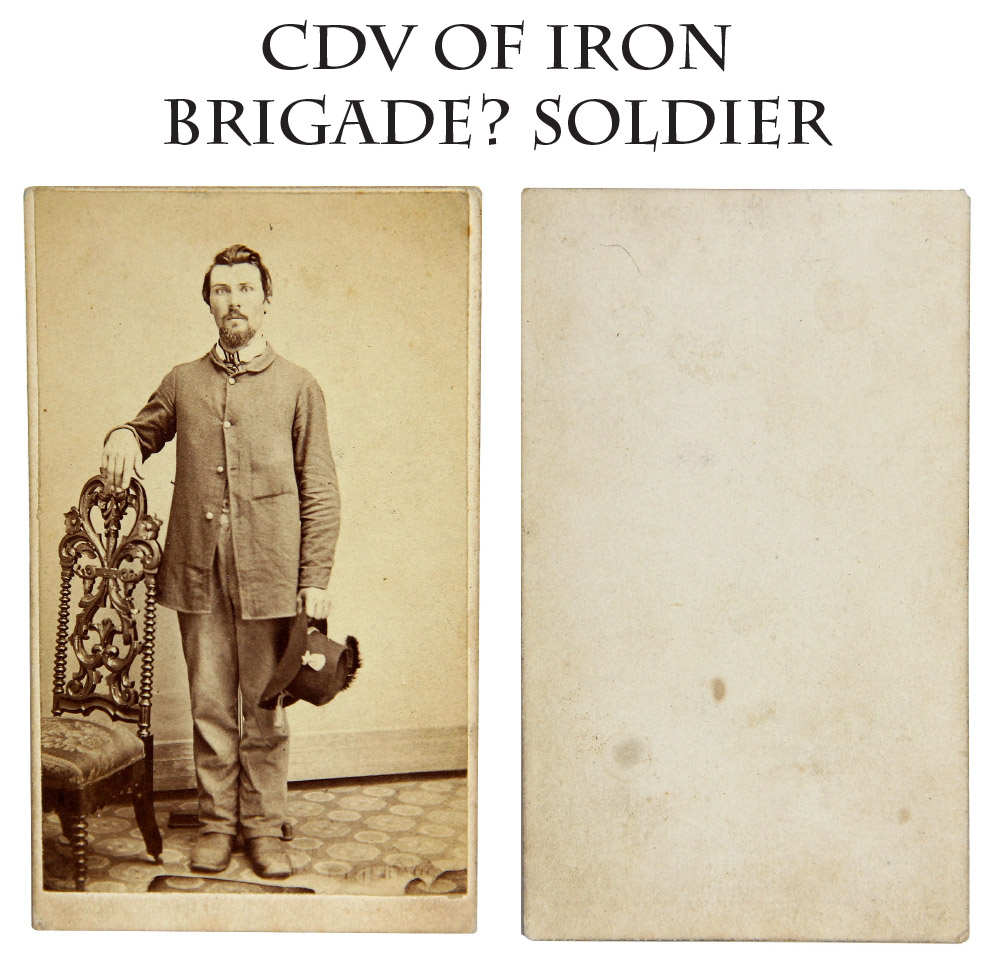
15-11-89 … CDV of Iron Brigard Soldier? …
This cdv came to me with an identified 24th Michigan officer. The association is not strong enough to say for certain he was a member of the unit as well, but use of the army dress hat with a rather plain four-button sack coat is suggestive. Our man is posed in a studio with his arm draped over a photographer’s chair. The sack coat has rather square corners and may be a commercial purchase. No backmark to help narrow it down, but a nice image none the less and priced right …
bj-16025
… $50.00
– SOLD
Click Here to E-mail Us!
Call us @ 419-842-1863

15-11-92 … Very Scarce Whitney Federal Contract M1861 Springfield Rifle Musket …
An extremely scarce contract for the collector. Not as scarce as the New York contract listed above, but darn scarce. 1864-dated Model 1861 .58 caliber “Whitneyville Contract” percussion rifle-musket in VG to near fine condition. This musket was a product of Eli Whitney’s firm called the “Whitney-ville Armory”. All steel surfaces are attractive attic plum brown patina with strong markings, except the barrel date. The stock edges are sharp. No cleaning, no burnishing, no alterations…. overall strong “attic found” condition. Lock is marked with eagle over ‘U.S’ to the right of the hammer and the date “1864” behind the hammer. Under bolster is “WHITNEY-VILLE” in strong sharp stampings. Barrel proofs of VP & eagle’s head are sharp. The barrel date is obliterated by pitting at the breech. This great old musket is 100% original, 100% complete, and mechanically perfect. Rear sight is the proper early 1855-1861 style short range sight with the little
“back porch”
on it. Ramrod is straight style which is proper for this model. Bore has rifling but not sharp. Federal stock cartouche visible and legible on left side opposite the lock, between the two lock screws. Whitney was slow to fill his federal government contracts, except for the famed Plymouth Navy Rifles. He supplied Connecticut with 61 style muskets ahead of his federal contract. He initially agreed to manufacture 40,000 M1861 US Rifle-muskets for the Federal government early in the war. After he finished his Plymouth rifles, and his Connecticut contracts, he voided his first federal contract and signed one to supply 15,000 of these M-1861 muskets instead of the 40,000 he originally promised. He did so cleanly, and to federal specifications, in 1863 and 1864. This is one darn fine example of this scarce Federal Whitney ’61 Springfield … 40″ barrel … 56″ overall length. You can attend ten gun shows and will not likely see one of these contract muskets offered for sale …
eej
… $1,550.00
Click Here to E-mail Us!
Call us @ 419-842-1863
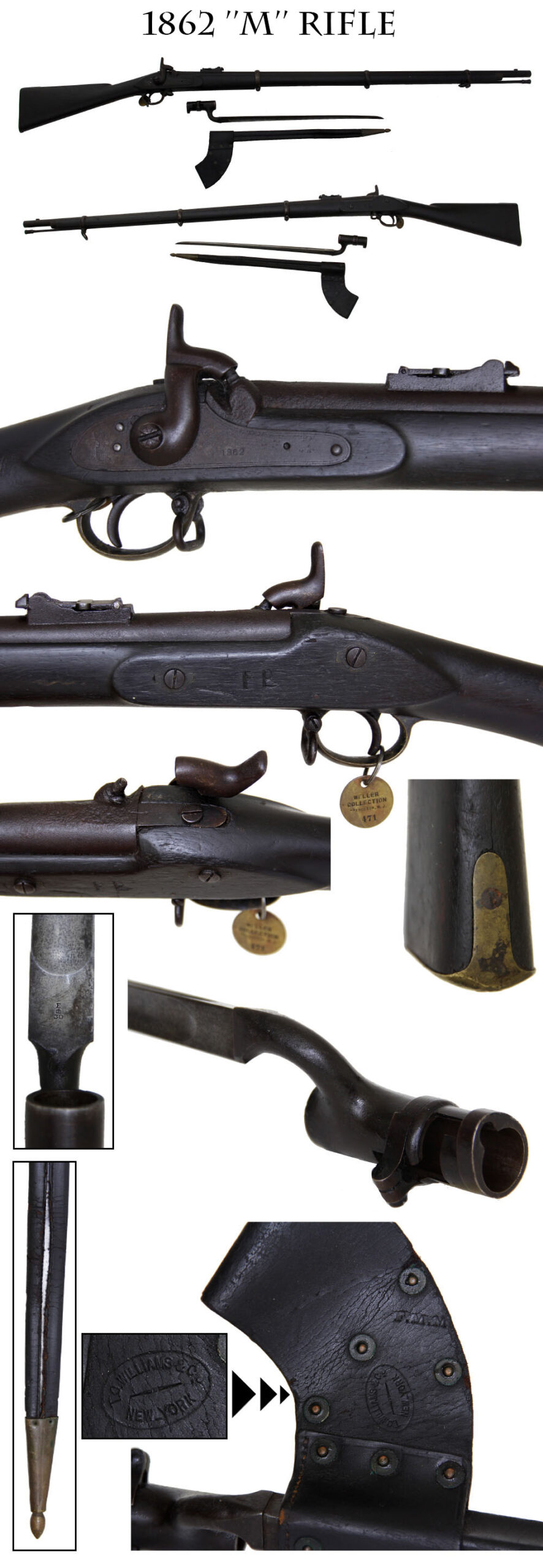
15-11-93 … 1862 Dated Musket M-Rifle Enfield …
Cal. 58. … 39 bbl. … Another very scarce US contract musket. This is a nice “as found” example of an 1862 dated “M” rifle as made by J.P. Moore & Sons in New York City early in the Civil War. These guns are fairly scarce and for many years were thought to be Confederate. When I began collecting as a kid, “common wisdom” dictated that these were absolutely CSA muskets. They appear in several texts as Confederate, some with North Carolina agent stamps in the stock. Current knowledge states they are unquestionably New York contract guns. Very scarce guns, but not Confederate. This musket is all original and complete, along with an Enfield bayonet in a New York contractor marked scabbard. Bayonet and gun metal are all dark and uncleaned and match very well. This gun conforms almost identically to the British Model P1853 Enfield rifle musket, having brass nosecap, trigger guard, buttplate and lock escutcheons. Balance of the gun is steel, including the Enfield style slotted ramrod. Gun overall is very good and sound, metal being dark with gentle surface pitting No discernible bbl markings, Lock marking of eagle holding a shield with “M” and 1862 date are well struck and easily discerned. Stock is sound and solid with numerous small storage dings and dents. There are a pair of initials “PR” carved opposite lock in stock. Accompanying bayonet matches gun perfectly. Blade is gray and smooth. Accompanying US regulation bayonet scabbard is sound and solid with areas of crazing and stitching is loose over half its length. Very scarce and very desirable …
afjj-bjj-exhaa
Musket by itself … $1,675.00 … Musket with bayonet and scabbard … $1,925.00
Click Here to E-mail Us!
Call us @ 419-842-1863
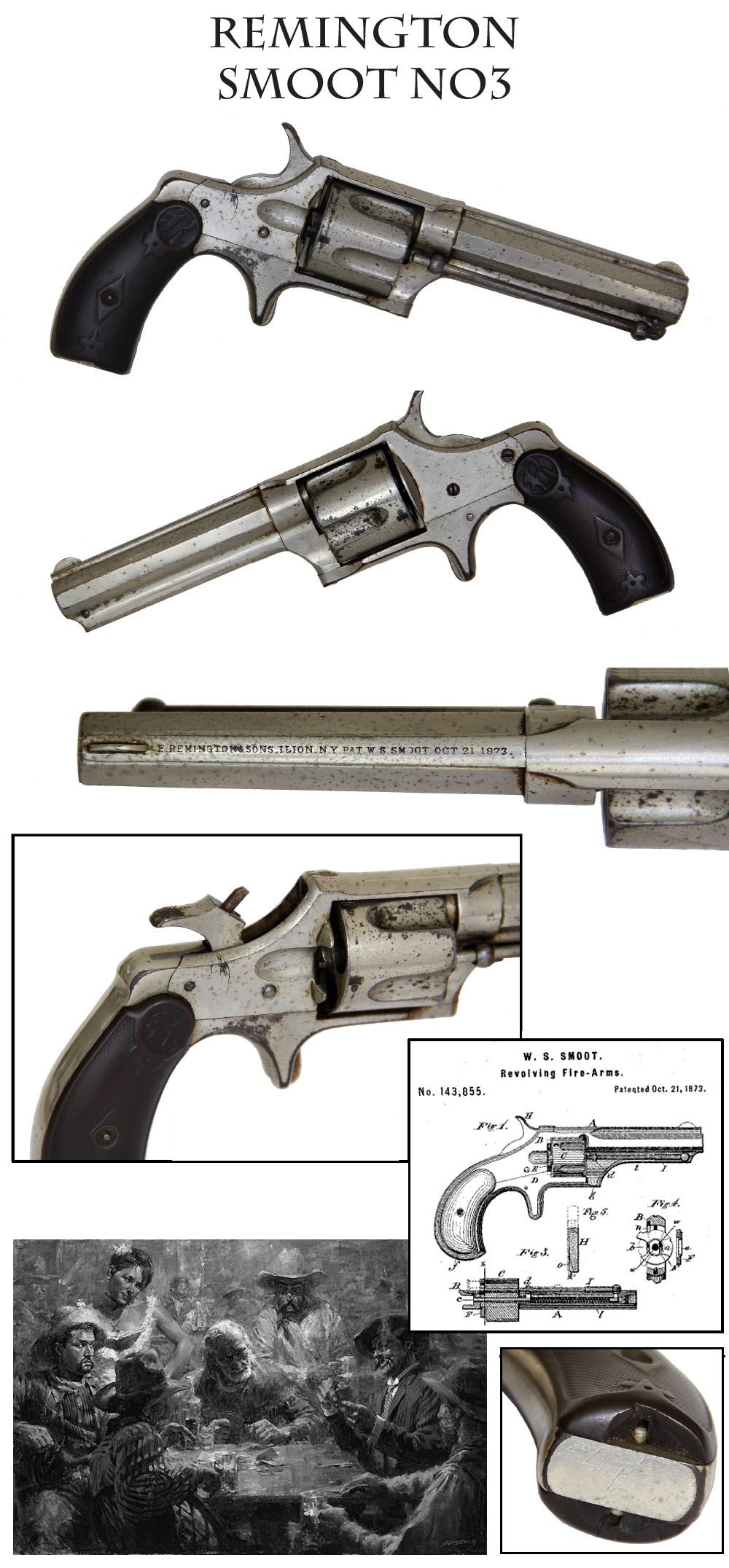
15-11-94 … Cowboy Gun – Remington Smoot New Model No.3 …
Five-shot .38 caliber rimfire revolver with hard rubber grips and full nickel finish. Made from about 1878 to 1888, these revolvers were strong competitors of Colt. Production estimated at 25,000. Overall VG to Fine … Some softening to the details of the hard-rubber grips from handling and some dappling to the nickel finish but little flaking or wear- just a spot on the right aft of the trigger and the edges of some cylinder flutes. Clear Remington & Sons and 1873 patent markings on the barrel rib. Bottom of grips have chips as though an owner once thought about attaching a lanyard around the butt strap, then changed his mind. One of the small revolvers you might notice tucked in the waistbands of western poker players trying their luck, or in the garter of a Saloon Gal who knew her business and her clientele. An affordable collector’s weapon from the days of the cowboy, made by an iconic maker … One heck of a friendly price …
bej
… $295.00
Click Here to E-mail Us!
Call us @ 419-842-1863

15-11-95 …
Mexican War Dated US 1842 Percussion Pistol …
The 1842 pistol was among the last of the US single shot martial pistols, before Springfield took one last stab with the 1855 Maynard tape pistol carbine. The 1842s were made by Aston and by Johnson, both of Middletown, CT. These .54 caliber pistols were produced from about 1845 to 1852. (Some were also made by William Glaze at the Palmetto Armory in South Carolina, but they are a horse of a different color and a study unto themselves.) This one is the standard US model … has decent wood still showing a good WAT cartouche on the rear of the side flat, a tight wood to metal fit, and just some expected light handling marks. The brass patina is a very attractive yellow and gold, and the lockplate shows a pleasant smoky grey patina. The barrel is a smooth attractive plum brown color. Has sharp barrel inspector initials, and date of 1847. The lock is clearly marked
US H. Aston
and
MIDDtn Conn. 1847
. Nice to have matched Mexican War dates on one of these. Overall VG++ condition … very honest and nicely aged. 100% original, 100% complete, mechanically perfect, Mexican War date! These pistols were carried in the pommel holsters of dragoons during the western expansion preceding the Civil War and continued in service in the Civil War usually in southern hands. We tend to think of them as strictly Mexican War to early Civil War, but as late as 1864 a Yankee looking over the battlefield at Haws Shop noted scattered horse pistols on the field, apparently lost or discarded by newly arrived Confederate cavalry. If the rebs could capture a yankee revolver, the old single shot wasn’t of much use any more. Might as well discard it. Or if you had fired your one shot, and the yanks were getting close… you might decide to turn and run without that giant old hammer, just leave it behind.
… Matched 1847 dates, 100% original … $950.00
– SOLD
(may have one more)
Click Here to E-mail Us!
Call us @ 419-842-1863

15-11-96 …
Low Serial Number Smith & Wesson No.2 Army Revolver …
Very Good example of the popular 32 caliber rimfire six-inch, six shot pistol with a serial number of 17,390 indicating a good early-war production date. Very popular because of the weather-proof self-contained cartridges. The grips are excellent. The metal shows a goodly amount of nickel finish, in protected areas. The balance of the steel was polished by a previous owner, I assume to brighten it to match the remaining nickle. Custer owned a pair of these and they were popular with western travelers, gamblers and the like. Even Wild Bill Hickock kept one as a back-up piece. Overall VG. 100% original and complete. Functions fine but you need to point the muzzle toward the ground when cocking to engage the “hand” which rotates the cylinder. A nice example at a friendly price …
eej-ahy
… $675.00
– SOLD
Click Here to E-mail Us!
Call us @ 419-842-1863
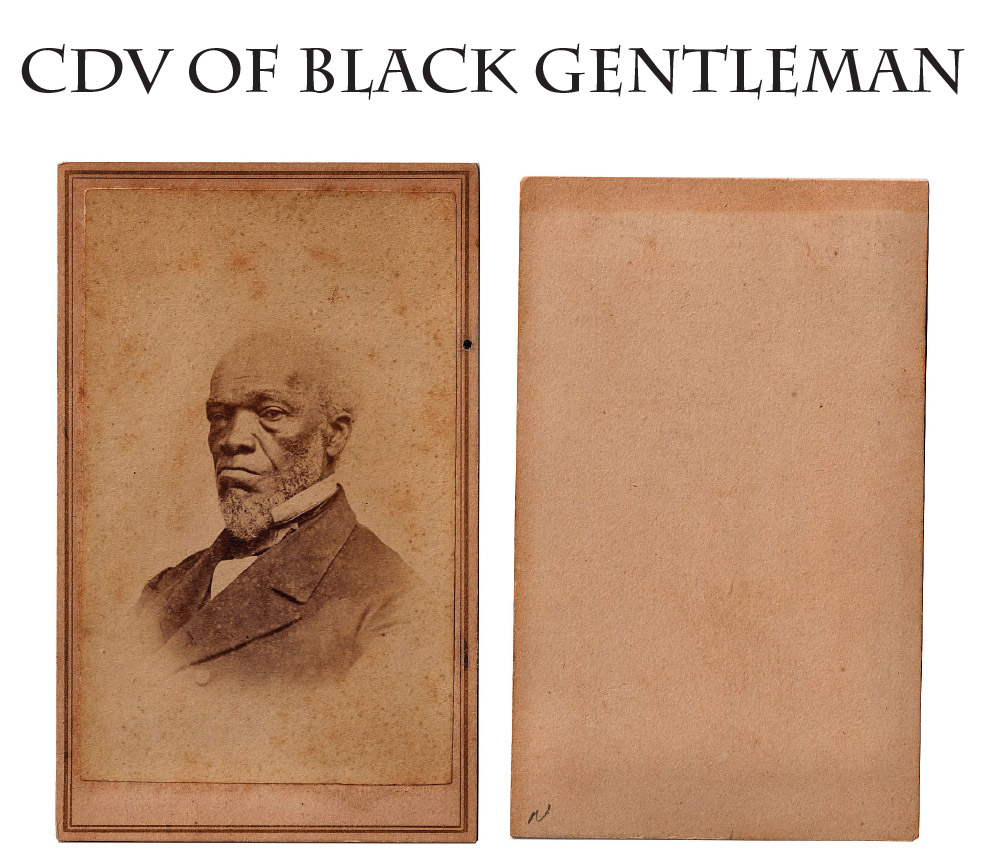
15-11-97 … CDV of a Civil War African American …
Sharp vignette portrait bust of black gentleman in formal dress. No back mark or identification, but this guy has the look of experience and determination. His mouth is slightly down turned, giving the impression of a long hard life, but his fixed serious expression indicates someone not to be trifled with. At the same time he has raised one eyebrow slightly, indicating to the viewer he has taken your measure and he is not terribly impressed. One very strong portrait. Slight foxing spots overall but nice tones and a crisp card …
beyy
…
a real friendy price
… $50.00
– SOLD

15-11-98 … U.S. Navy Officer George A. Flagg Jr. …
Nice vignette portrait bust of a USN cadet by Fowler, Newport R.I. Opposite U.S. Naval Academy. Flagg entered the US Naval Academy as a midshipman 9/21/61 and graduated 11/22/64. He made Ensign 11/21/66; Master 12/1/66; and Lieutenant 3/12/68. He died 6/20/69. A very crisp view of the young naval officer
… $50.00
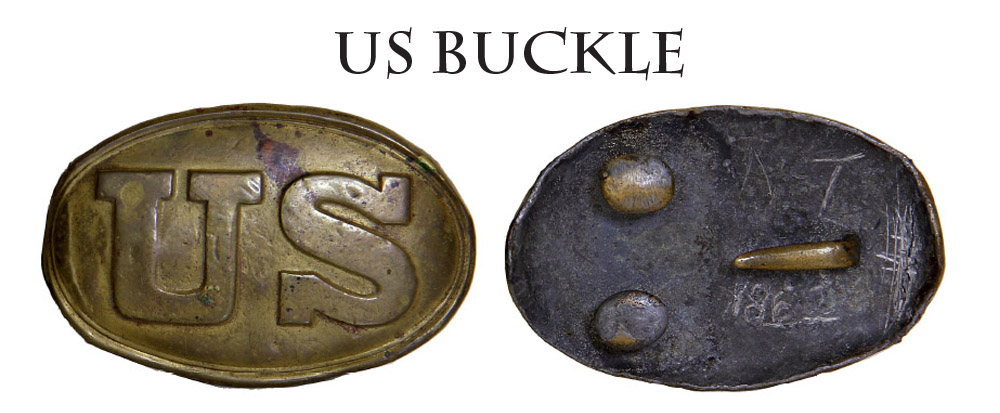
15-11-99 … US “Puppy Paw” Belt Buckle …
The brass oval US belt plate with a lead solder filled back is the quintessential Civil War belt plate with lots of variation among makers. Non-dug, these are both early “puppy paw” style plates, one of which could date back to the Mexican War. The “tell” is the round studs (as opposed to oval) that secure the buckle to the belt. Each of these has the standard contoured heavy hook to fasten the belt closed.
Early rounded studs beginning to show slight oval shape … very early Civil War production… light bends to the left and right edges, minor dings and a stain at upper center to the face. Scratched note on the back “N T 1862”. Much much rarer than arrow hook buckles, and also scarcer than the oval “puppy paw” stud buckles
… $295.00
Click Here to E-mail Us!
Call us @ 419-842-1863
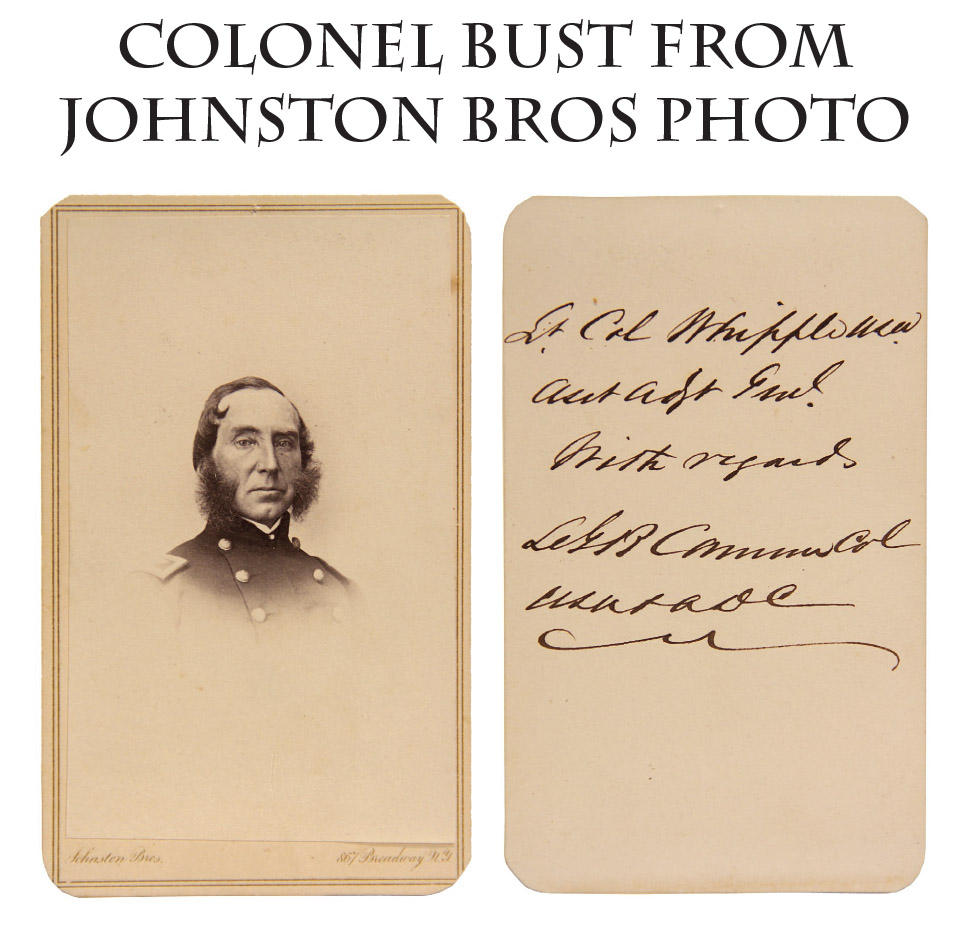
15-11-100 … Special Aide to Lincoln / African American Related / Signed CDV of Colonel Le Grand Bouton Cannon, Aide-de-Camp to General Wool, influential in the Union Defense Committee in 1861,
the sheltering of escaped slaves at Fortress Monroe, the enlisting of black troops in the army, and internal army politics. Crisp vignetted bust view of a field-grade officer with flashy sideburns! Cannon was from New York and had served as a volunteer on General Wool’s staff before the Civil War. When most of Wool’s staff resigned and went south, Cannon and a few other prominent New Yorkers joined his staff as volunteers, Cannon acting a volunteer ADC to Wool from April 23 to August 28, 1861. During this period he took an active part in the Union Defense Committee of New York in corresponding with and aiding various northern governors, like the Governor of Illinois, who were trying to obtain arms, etc., and organize without adequate leadership from Washington.
Cannon was officially appointed Major and AADC on Wool’s staff August 28; and Colonel on Feb. 1, 1862. He accompanied Wool to Fortress Monroe, Virginia, which they preserved for the Union. Cannon was involved in formulating the “contraband” policy about escaped slaves who had sought protection at Fortress Monroe and was intimately involved in some of the army’s political infighting. His reminiscences published after the war include a number of first hand accounts of the Monitor and the Merrimac, time spent as a special aide to Lincoln, and experiences with Secretary Stanton, etc. Cannon resigned June 11, 1862, but rejoined Wool’s staff as a volunteer for a time thereafter, until Wool’s retirement in 1863. Cannon’s accounts are a real insider’s view of the doings at various army headquarters. He had been offered the military command of Norfolk, before resigning.
The card is presented to Lt. Col. Whipple, who is probably William Dennison Whipple, West Point class of 1847, who served until 1890, was both ADC and AAG at different points in his career, served on Gen. Hunter’s staff, the staff of General Thomas, and after the war as ADC to Sherman from 1873 to 1878: “Lt. Col. Whipple USA / Asst Adjt Genl / With regards / Le GB Cannon Col / USA & ADC.” Their staff duties had probably brought them into connection at some point, though Whipple was a New Yorker like Cannon.
A significant subject involved in some important early war doings
… $85.00
– SOLD
Click Here to E-mail Us!
Call us @ 419-842-1863


CIVIL WAR ERA FRENCH SEMI NUDE LADY CDVs. INCREDIBLE FOR THE PERIOD
Carte-de-visite format albumen photos caught on in the late 1850s. Men being men one of the first things we took pictures of was…… Naked Ladies of course. The following seven cards are commercial products of the late 1860s or 1870s. Some display small inventory numbers at the top in brown ink. None are backmarked, of course. All use the same model. (Small modern collector/dealer numbers in pencil on the reverse.)
15-11-77 … Barefoot Mostly Topless Woman CDV …
Our girl lounges in a cushioned chair. Looking to the right and up slightly as if a visitor has just come in. She wears a rather sheer undergarment, has a slight smile and a nice pair of earrings. Two small wear spots top left and mid right
… $125.00
– SOLD
Click Here to E-mail Us!
Call us @ 419-842-1863
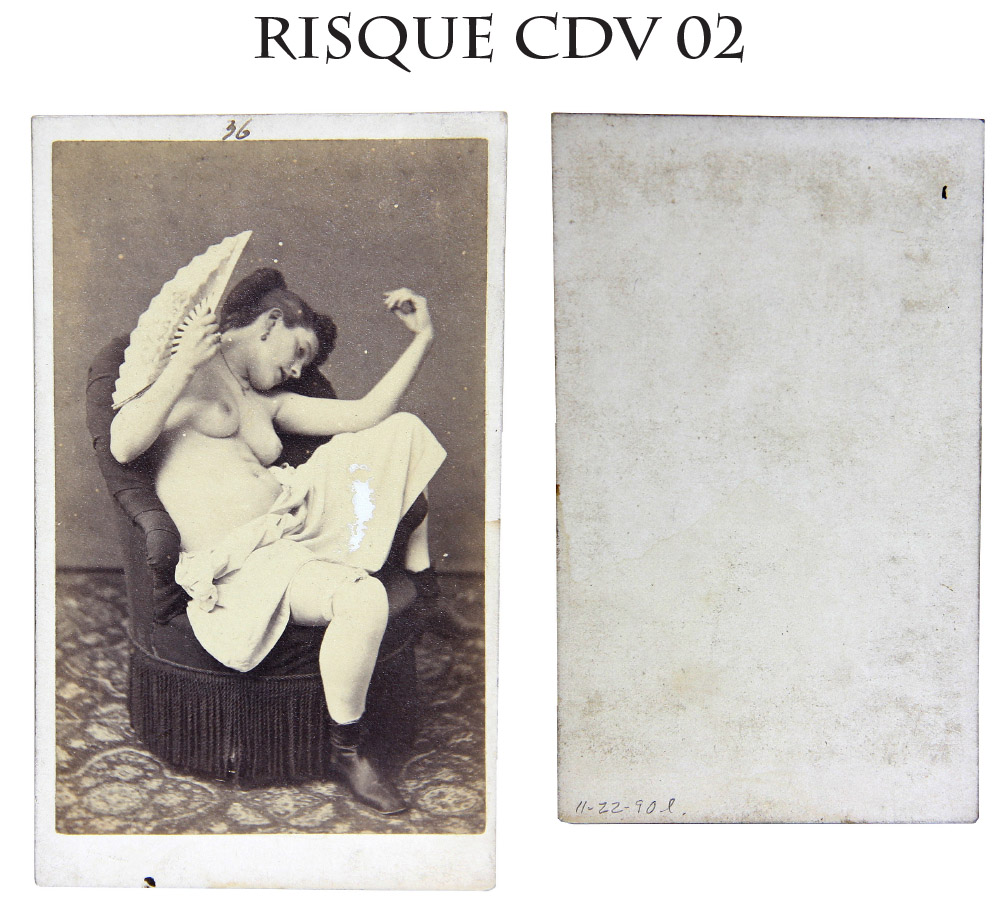
15-11-78 … Topless Woman Fanning Herself …
Is it just me or is it getting hot in here? In this one our gal has made the mistake of donning a warm pair of stockings and shoes and somewhat heavier garment. The photographer has left the thermostat on high, however, and she has had to break out her fan and take other measures to increase air circulation and cooling. Slight wear mark to the fabric draped over her left leg
… $165.00
– SOLD
Click Here to E-mail Us!
Call us @ 419-842-1863

15-11-79 … Topless Woman Fanning Herself CDV …
A duplicate shot of the above. No wear spot and slightly richer tones. Number “36” on the upper edge of the card in case you are keeping track
… $165.00
– SOLD
Click Here to E-mail Us!
Call us @ 419-842-1863

15-11-80 … Topless Woman CDV …
“Oh my! This fan is just not doing a thing!” Well, our gal has just about had it with this photographer’s lousy air conditioning system. She had given up fanning herself, thrown one arm back over her head displaying a little continental flair, and is dreaming of something else, a far off exotic locale, a dreamy luncheon, or perhaps wishing she had brought that cooler outfit she wore in the first card
… $165.00
– SOLD
Click Here to E-mail Us!
Call us @ 419-842-1863
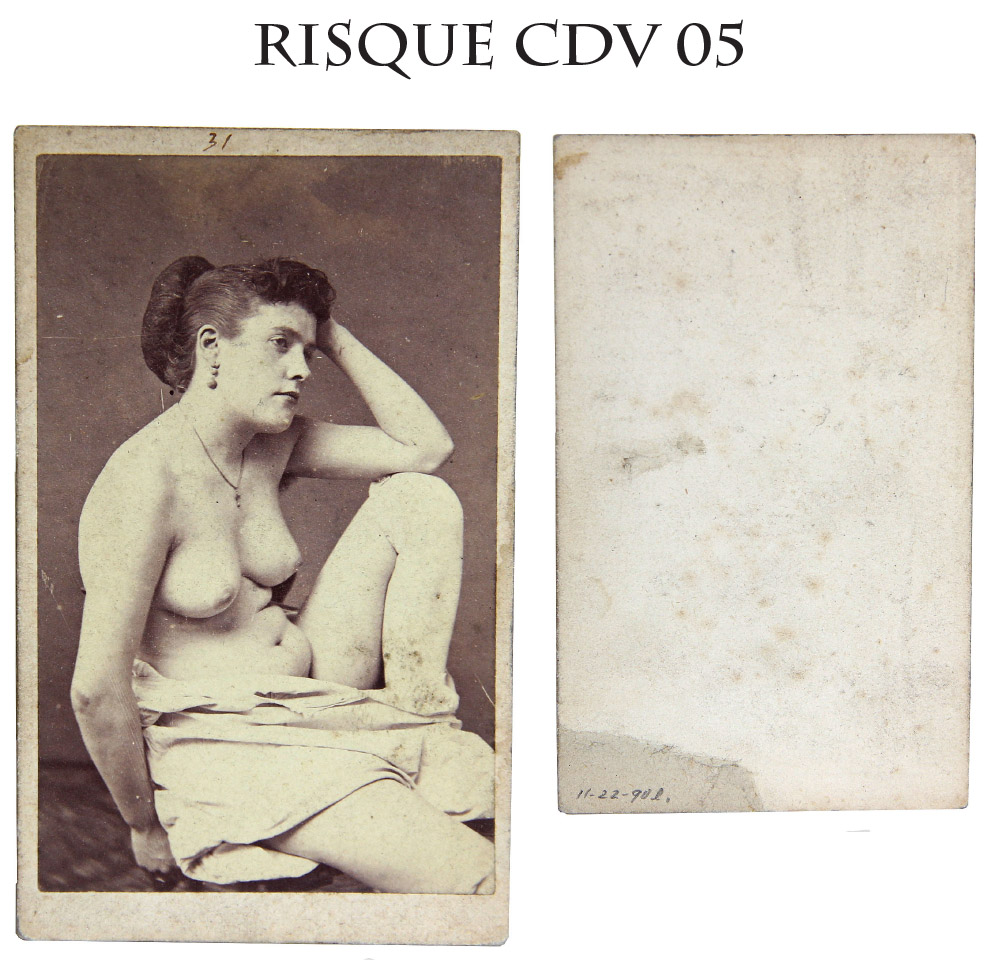
15-11-81 … Topless Woman In Deep Thought CDV …
Now she’s downright bored. Posed perched on a table or edge of a seat, our gal is now wishing she had gotten the mint frappuccino rather than the carmel latte on the way over to the studio. Propping up her head on her hand, and resting her elbow on her knee, the drapery around her waist, she wears the stocking shown in a couple of the other photos. This pose provides a much clearer view of her necklace. Minor foxing spots. A stain and wear spot on reverse not affecting the image
… $165.00
– SOLD
Click Here to E-mail Us!
Call us @ 419-842-1863

15-11-82 … Topless Woman and Fan CDV …
Back in that plush chair with one leg draped over the arm, our girl leans back and contemplates the ceiling, pondering career alternatives. “The necklace and earrings are great,” she thinks, “and I love this fan, but these wool stockings are getting to me, and my feet ache from these high-top shoes.” The photographer has thoughtfully supplied her with a bath towel. Minor waterstain on a reverse edge that does not come through. Nice tones
… $165.00
– SOLD
Click Here to E-mail Us!
Call us @ 419-842-1863
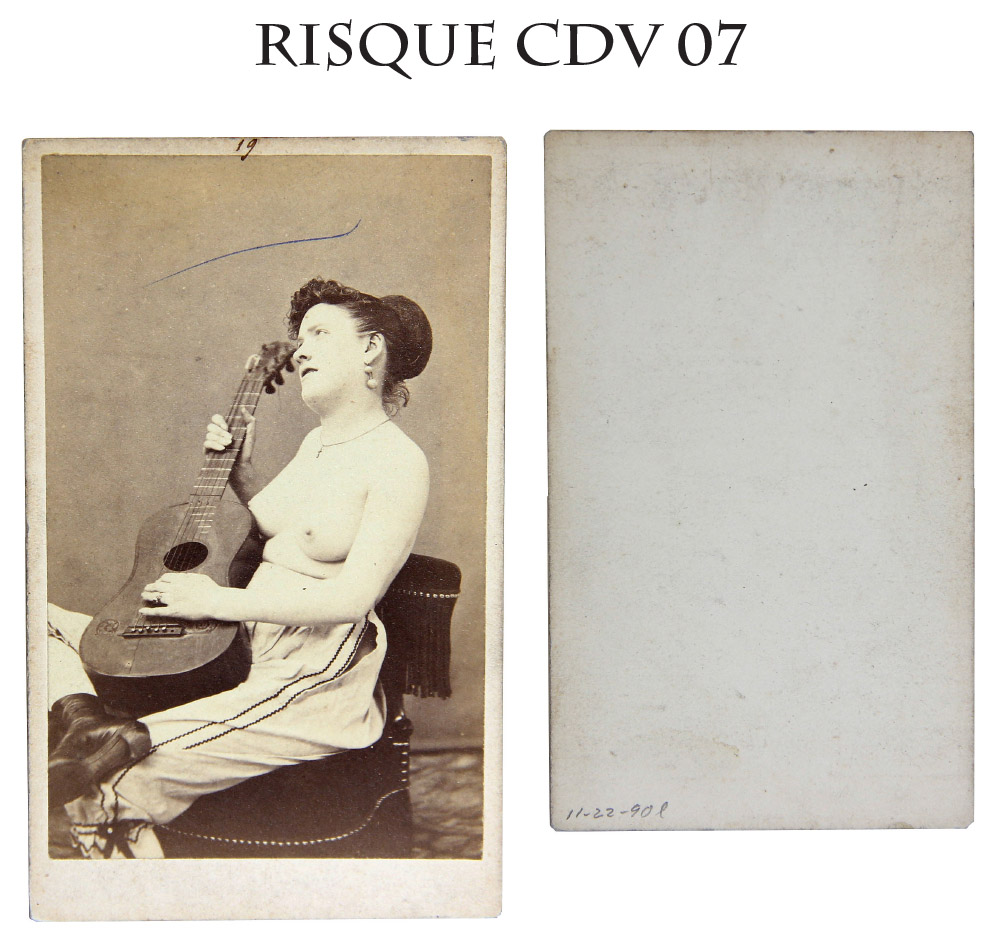
15-11-83 … Topless Woman and Guitar CDV …
“I have always wanted to take up the guitar …” Having had enough of the modeling business, Charlene has turned over a new leaf, bought a pair of pants and decided to make a living playing the guitar. She gazes up to the left, thinking of floating downstream in a rowboat, looking for inspiration, or trying to remember the chord sequence for “Oh, Susanna.” In any case, she is now more relaxed, has moved to a new chair, and the photographer seems finally to have gotten the AC fixed. A very narrow pen line crosses the image above her head, otherwise inspiring
… $185.00
– SOLD
Click Here to E-mail Us!
Call us @ 419-842-1863
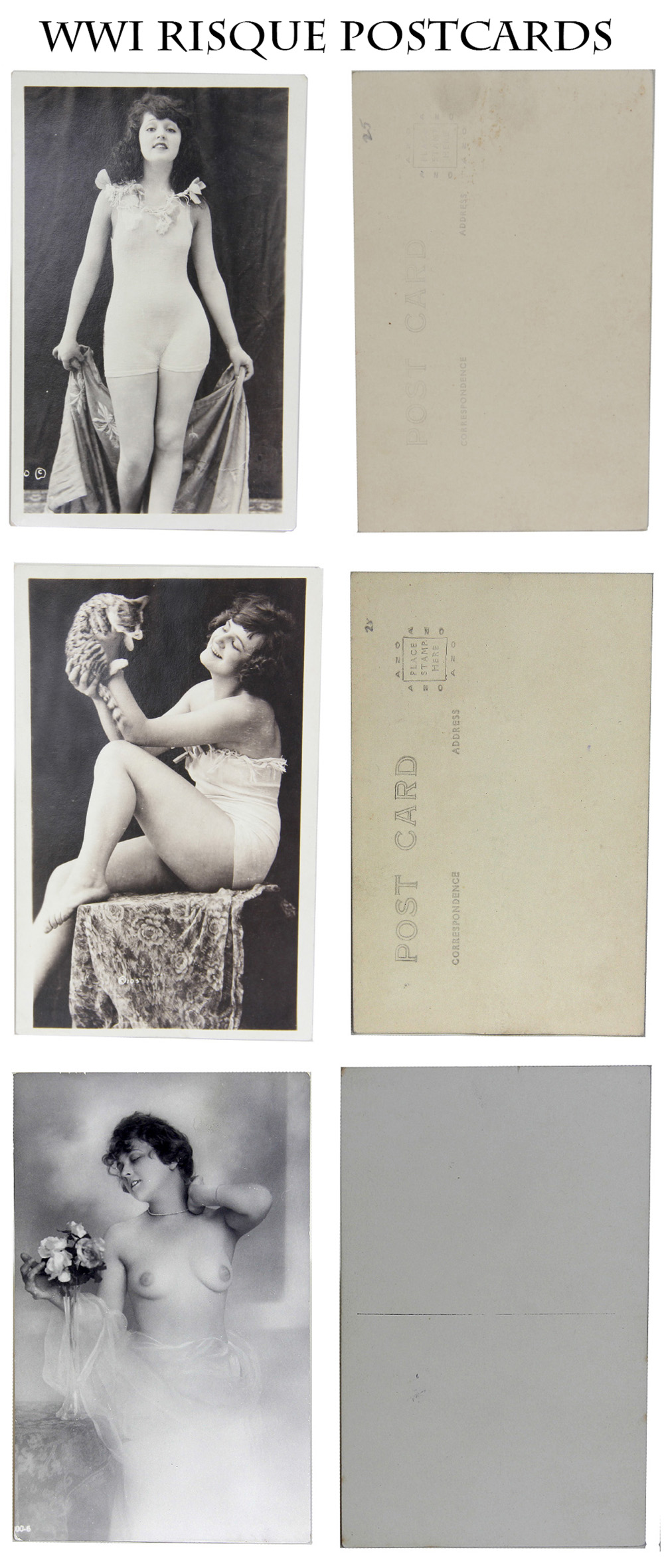
15-11-66 … Three Risque Real Photo Postcards …
The advent of the real photo postcard spelled the end of the cabinet card. Their heyday was roughly 1903 to 1939, when a combination of pre-printed card stock for printing out images and specially designed cameras made it possible for hobbyists and amateurs to take and print their own photos. Men being men, about the first thing we thought about taking pictures of was . what else? . undressed women. The following three examples are commercial efforts in the genre: with artistically posed models. The first two actually have postcard printed on the reverse, but it is unlikely any would have made it through the postal system at the time.
[a] What can I say our gal is wearing a necklace of flowers and a smile. She is holding a kimono or flowered dressing gown behind her like an unveiling and her sheer outfit keeps one guessing about what you are actually seeing and what is being suggested.
[b] A smiling woman is perched on a covered table top. She is smiling, cocking one leg up, and dressed in a skimpy undergarment. Not much is showing, but she seems to enjoy playing with her cat.
[c] A very dreamlike vignette you woman with a necklace and gauzy dress that won t stay up admires a bouquet. Somethings don t change- at least as I remember them. A small white number in the negative at lower left is a photographer s inventory number. Time to reorder. All three lovely ladies for.
… $50.00
Click Here to E-mail Us!
Call us @ 419-842-1863
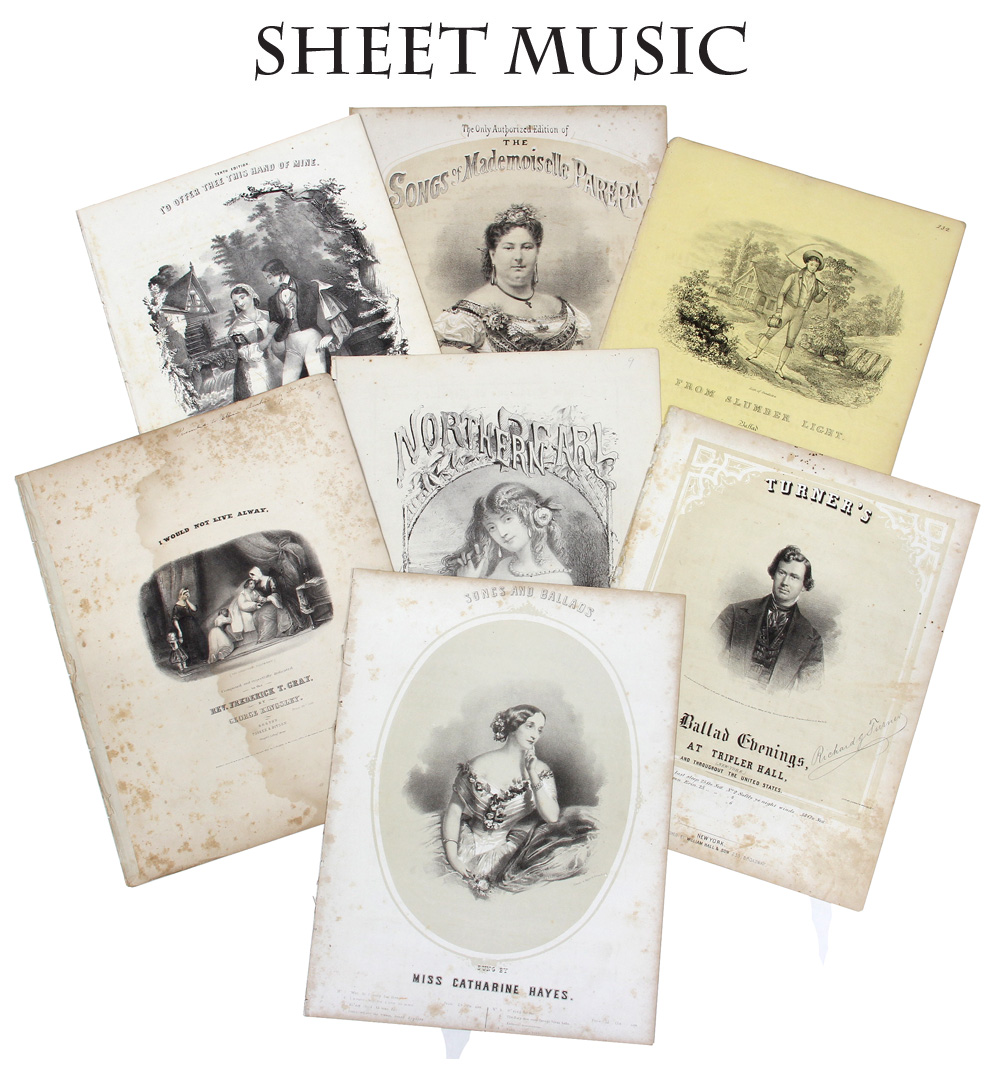
15-11-101 … Sheet Music with Good Graphics …
I have a nice selection of Civil War or slightly earlier sheet music with nice graphics on the covers. I believe I have around 30 pieces. Aside from “Home Sweet Home” the titles, and lyrics, will probably not be familiar. (You can be the first one on your block to introduce these CW tunes to the neighborhood.) They tend toward the romantic and sentimental. Many are reminders of the fragility of life in nineteenth century America, and they would look good framed or even in a collection as examples of life on the homefront. There are certainly many stories in soldier letters of visits to local houses during lulls in campaigning where singing in the parlor was a welcome break in army life. For those stationed on the frontier it was one of the few wholesome recreations available to stave off boredom. Each piece has a nice cover graphic … noco …
Priced each $15* … Two for $25* … Five for $65*
*my choice
Click Here to E-mail Us!
Call us @ 419-842-1863
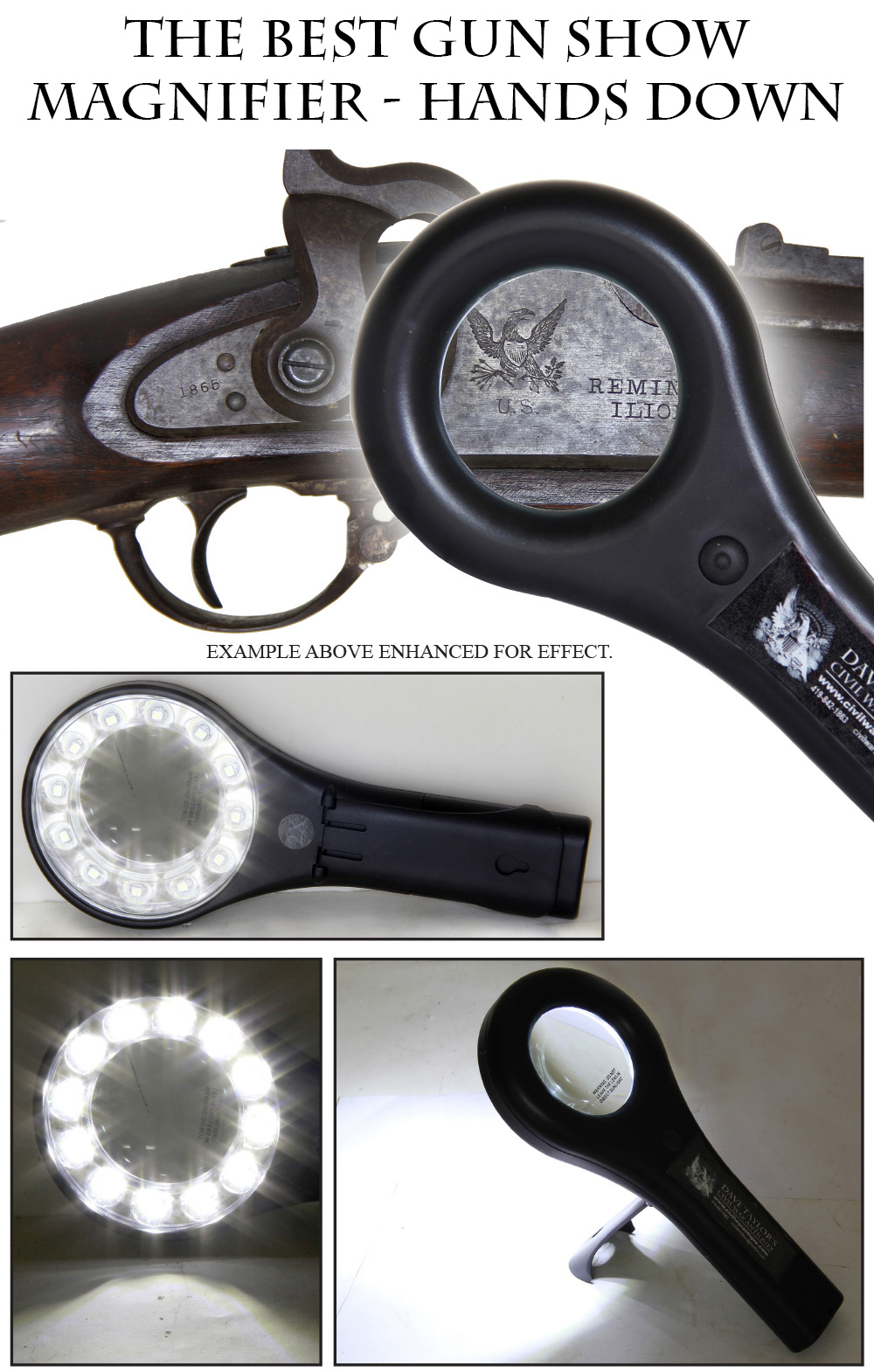
15-11-102 … INCREDIBLY EFFECTIVE LIGHTED MAGNIFYING GLASS / PERFECT FOR INSPECTING ANTIQUES …
You have undoubtedly seen collectors at the shows running around with one of these magnifying glasses in their hand. There’s a good reason … they are SUPER! Months ago I bought one for myself and loved it. Then the local guys wanted one and I bought another half dozen for them at $25 each at the next show … Then I bought another one for me when I arrived at a show and discovered I’d left mine at home. I figured with as many as I was buying at retail, I might as well buy them in bulk and sell them at the shows and on the web page. These are absolutely essential for anyone buying antiques at shows or auctions. The intense illumination from the twelve LED light sources and 2x magnification exposes “artificial age” such as cold-blue on metal or amber shellac on wood. Shine this light and you will see if someone has “aged” or repaired the item you wish to buy. The magnification accompanied by the intense illumination reveals cracks and repairs that the naked eye cannot pick up. Requires 3 AA batteries (not included) …
$25.00
Click Here to E-mail Us!
Call us @ 419-842-1863
Layaways are Welcome
Need to split your order into multiple payments? No problem! A simple 20% earnest money deposit will hold your item for you.-acf
You can then pay it off in easy installments that fit your budget.
Read Terms Here
Items to Sell? Contact Us
I am always interested in buying ANYTHING from the American Civil War… Guns, Swords, Civil War Muskets, Knives, Uniforms, Flags, Medals, Badges, Diaries, Letters, Autographs, Buttons, photographs, tintypes, daguerreotypes, Insignia, Camp Items, Battlefield Relics, canteens, Drums, Etc… Call 419-842-1863 and ask for Dave Taylor.

